VIII. Radio
galaxies: Strange Powerhouses of Intergalactic Space-Time
Double-lobed and active galactic radio sources—jetting
ejecta
1948 and beyond
VIII. Radio
galaxies: Strange Powerhouses of Intergalactic Space-Time
Double-lobed and active galactic radio sources—jetting
ejecta
1948 and beyond
 (Above) the Sea Cliff Interferometer, Dover Heights, New South Wales (link); (below) John G. Bolton in August of 1952 at the International Union of Radio Science conference held at the University of Sydney (link).  Bolton, J., Stanley, G. (1948). "Variable Source of Radio Frequency Radiation in the Constellation of Cygnus". Nature 161: 312. doi:10.1038/161312b0. |

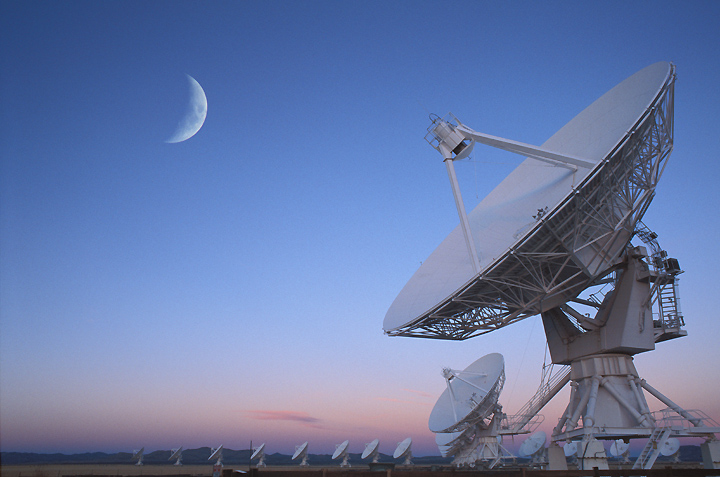





(www.abc.net.au/science/
slab/sim/story.htm)
(www.cv.nrao.edu/~abridle/images)
Over the
years, the double-lobes of the immense radio galaxies were
found to be vast jets of high energy / high velocity particles
being emitted from the cores of these galaxies. The source of
the energies generated in these massive explosive events (up
to 1060 ergs) has never been satisfactorily
explained in the standard black hole / accretion disk model.
In this section, we focus on the empirical radio wavelength
imaging and mapping of energetic radiogalaxies and their parts
of the sky. Many of these are associated with violent ejection
and interaction phenomena.












3C83 Radio /
optical superposition (NRAO)
Many of the following
active galactic systems emitting in the radio frequencies
were first observed optically in Halton Arp's 1966
Atlas of Peculiar Galaxies (Arp
Atlas frames and PDF,
Caltech) which contained a survey of nearly 340 unusual and
disturbed galaxies, with the original full resolution
optical photographic plates linked. Empirically, Arp
categorized the disturbed galaxies in his Atlas thus
in these 4 classifying figures:

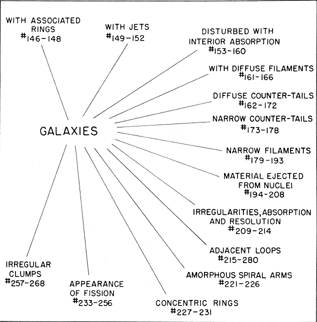


| In his 1966 preface, Arp wrote these words which raise questions still unanswered within the New Ptolemaic paradigm of the Big Bang cosmologies: "Forty years after the discovery that galaxies were independent stellar systems, we still have not penetrated very far into the mystery of how they maintain themselves or what physical forces are responsible for shaping their observed forms. The galaxies are the constituent units of mass and energy in the universe, and yet we are still challenged by such questions as: What causes the characteristic shape of spiral galaxies? How are elliptical galaxies related to spiral? How are galaxies formed, and how do they evolve?" |
One
excellent treasure of gorgeous data collected in the 1990s
on these much underappreciated galactic phenomena is from
radio astronomer, John Hibbard (NRAO, where he studied "the
fate of gas in interacting galaxies" (home),
from which he links a gallery
of radio galaxies (as well as what he calls a
living rogues gallery), with more images and data with
his abstract on another gallery. There is also a page for
the 20th anniversary of the VLA on "Gas
and Galaxy Evolution."

Following,
among other data sets, are images containing both optical
wavelength and HI emission line radiation contour imaging.
Here is a guide to the radiogalaxy imagery published, a
mosaic.

While many of the
images utilize the HI emission line, HII region from where
ionized Hydrogen thermal Bremsstrahlung emissions
emerge across multiple orders of magnitude of wavelengths
and energies.
 |
 |
Hibbard
& Yun in August of 1995 gave a presentation at the Cold
Gas at High Redshift meetings in Hoogeveen, NL: "The
neutral hydrogen distribution in luminous IR galaxies":
Featured were disturbed active galaxies
Arp 299, Arp 220, Mkn 273, VV 114, IC 883, NGC 1614, and NGC
2623. (The
HI data were obtained at the VLA in 9/94 (CnB array) &
1/95 (DnC array). The R image seen here is 600sec exposure
from UH 88" f/10 on 96nov19 with 0.6").
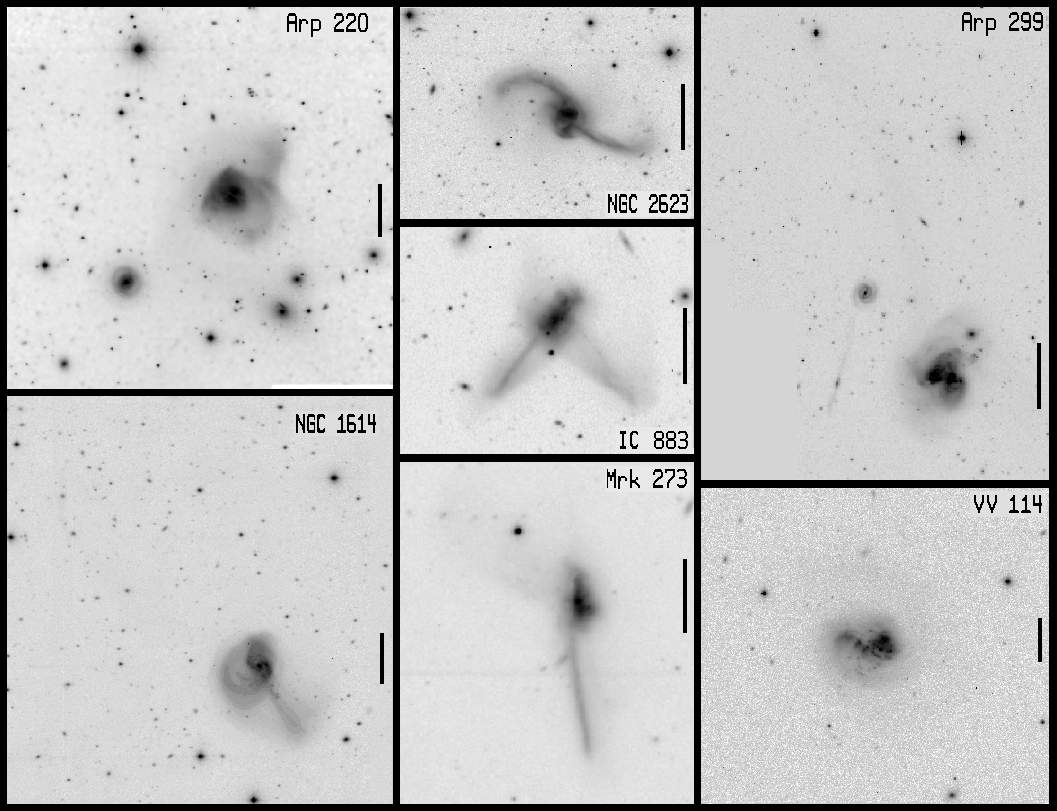





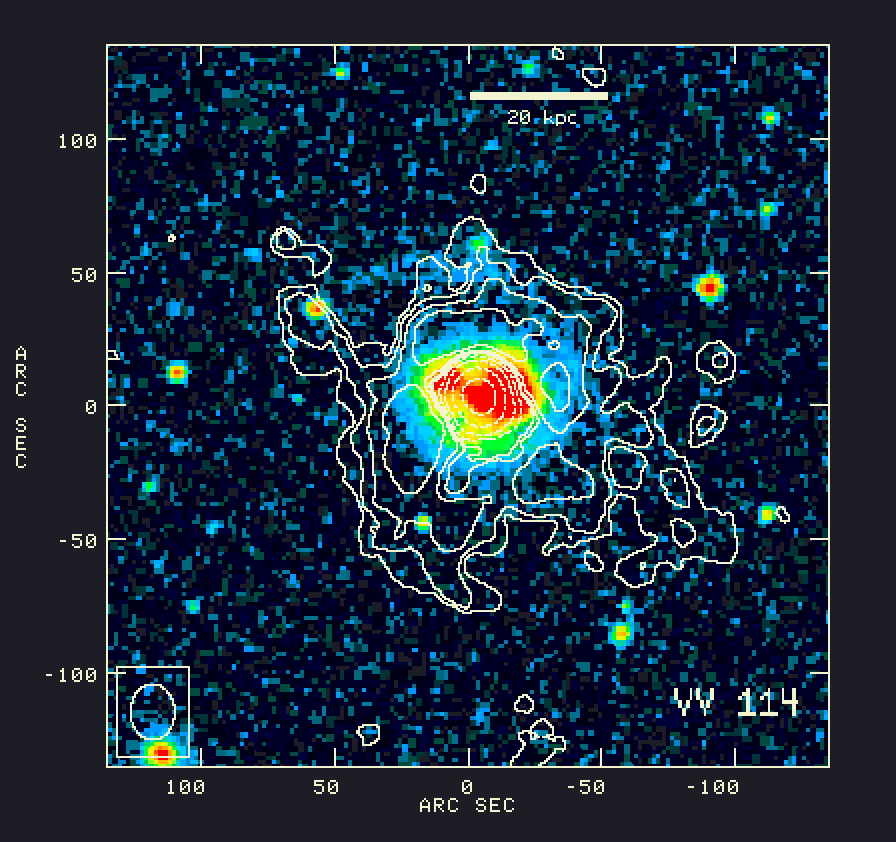




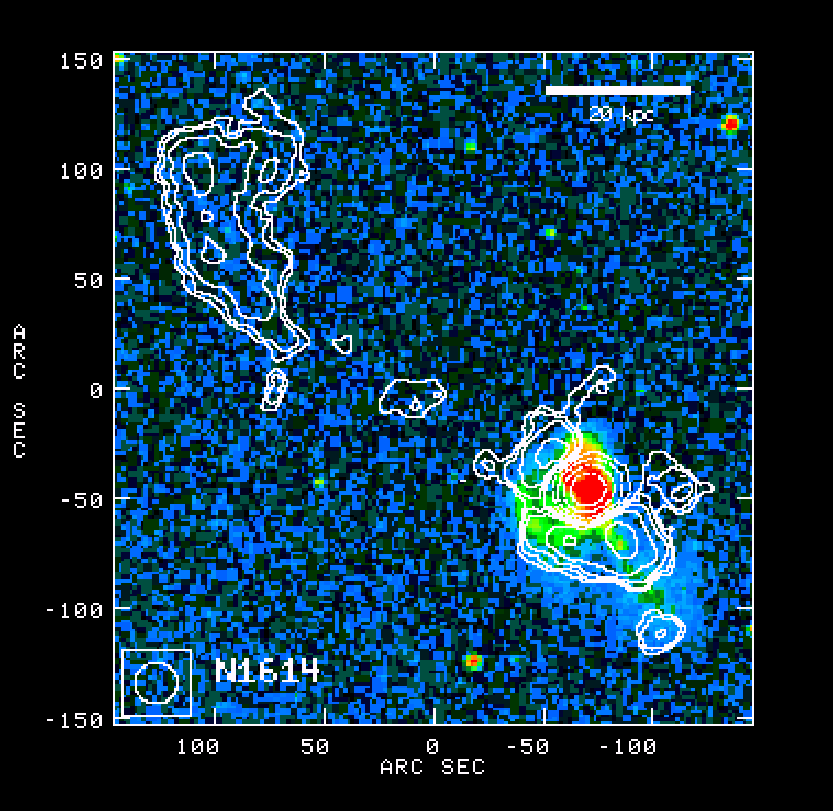

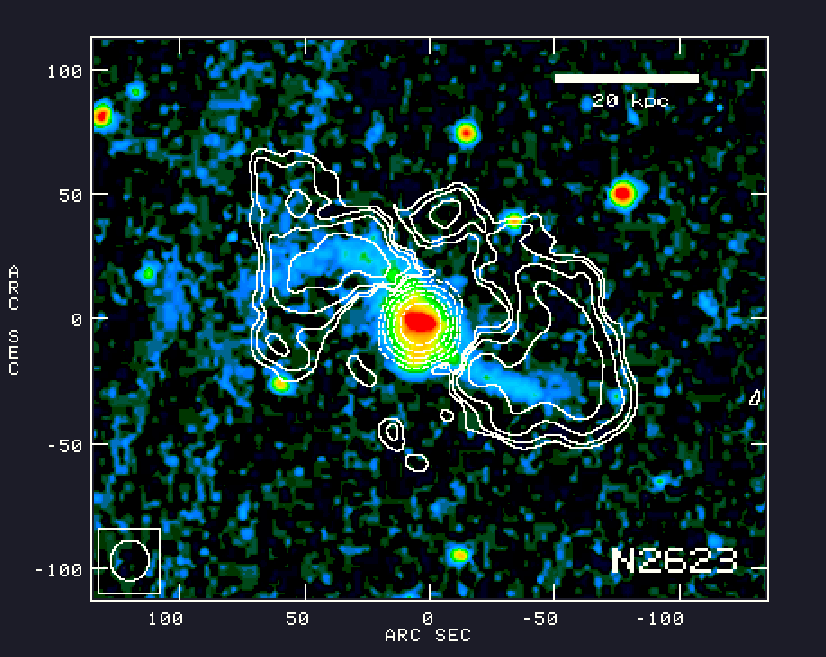
Radio
astronomer John Hibbard set up an NRAO page (up-kept until
2005) on "the fate of gas in interacting galaxies" (link).
According
to the received wisdom these active galaxies with gas ejecta
and so many more phenomena are all "merging systems." There
is growing reasons to question this entire paradigm.
An
illustration of the richness of the galactic phenomena with
Hydrogen I (HI) emission are the results of VLA observations
of HI in the galaxies of the Toomre
Sequence (Toomre, 1977). Arp 295, NGC 4038/9, NGC
4676, NGC 520, NGC 2623, NGC 3256, NGC 3921, and NGC 7252:
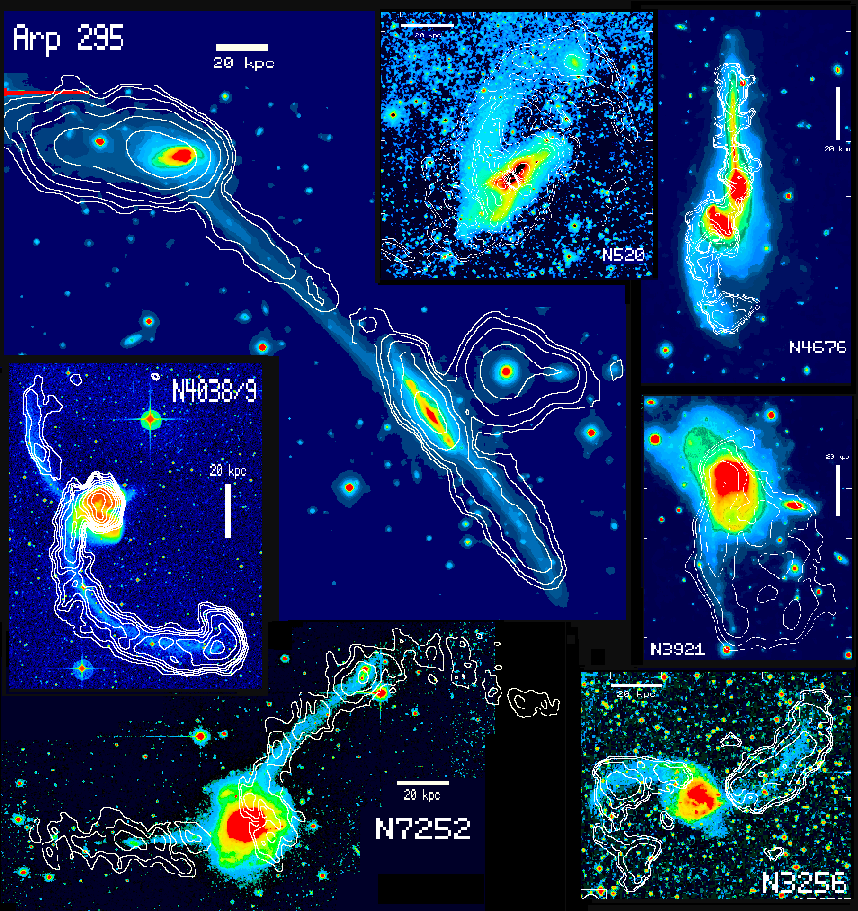
A mosaic of VLA HI observations from several "merging"
galaxies of the Toomre Sequence.
Optical wavelength views: Toomre Sequence HST

Laine et al. (2003) showing morphology of this
sequence (link).
Optical
high resolution photos of the colors of the Toomre sequence
may be found here (link):

Color mosaic of the Toomre Sequence of galaxies (link).
The
individual galaxies of the Toomre Sequence:
The
Arp 295 System

Arp 295
The NGC 4038 / 4039 System

NGC 4038 / 4039: Often considered the famous classic merger.
But is it really?
The NGC 4676 System

NGC 4676
The NGC 520 System

NGC 520
The NGC 3921 System

NGC
3921
The NGC 7252 System

NGC
7252
Even in these
putatively "merging" tidal systems in the Toomre sequence,
there are reasons to question the paradigm, in favor of
ejecta sources for these clouds of neutral hydrogen. Again,
what are the real origins of these phenomena? Do these
apparent HI ejecta involve primordial Hydrogen? So many
questions remain yet unanswered.
We
now turn to a few even more paradigm-unsettling HI phenomena
from the living rogue's gallery of galaxies (link)
and the new data entries since the published version (link),
including even detached or ejected HI systems (link).
Surprise
of discovery. In a fitting denouement to his and
others' superb observational work in radio astronomy,
Hibbard has a link heading exclaiming, "What you see is not
what you get! (or: 'Why I do HI observations of galaxies')"
(link).
When following that, one finds a java-linked composite image
with the heading, "Optically normal systems with disturbed
HI"! There one may compare the optical images of these 'optically normal'
galactic systems with and without the superimposed radio
isophote maps:

And with the
unexpected radio isophotes: "Surprise!"

The Living HI
Rogue's Gallery (link).
Here we include the HI emission (and absorption)
treasures from this gallery. Radio resolutions are given
in arc-seconds ("), field of view (FOV) in arc-minutes
('), and the contours are integrated intensity mappings
(link),
according to this equation from Spitzer, 1978):
Where contours
represent surface density with NHI
being units of H atoms per cm2 (assuming thin
optical density) obtained via the integrated
flux ![]() in spatial-temporal units of Joules,
multiplied by a term quantifying a full width at half
maximum (FWHM) size of the synthesized beam along the
major and minor axis. Solid contour lines indicate HI
emission, while dashed or light contour lines indicate
HI absorption. (Figure legends cited from the link are
placed in parentheses).
in spatial-temporal units of Joules,
multiplied by a term quantifying a full width at half
maximum (FWHM) size of the synthesized beam along the
major and minor axis. Solid contour lines indicate HI
emission, while dashed or light contour lines indicate
HI absorption. (Figure legends cited from the link are
placed in parentheses).

The NGC 7213 system
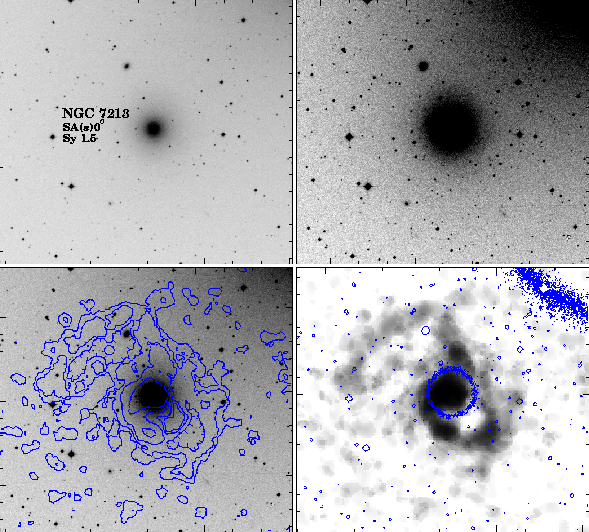
(Fig.
1. HI: ATCA, 52" x 42" resolution, contours=5
x 1019
cm-2
x 2n.
Optical: DSS, FOV=17' x 16'.
Notes: The gradient to the northwest is due to
the presence of a bright star.
Reference: Hameed, S., Blank, D. L., Young. L.
M., & Devereux, N. 2001, ApJ, 546,
L97.
The M83 System

(Fig.
2. HI: ATCA 9-point mosaic + Parkes 64m, 62" x
38" resolution.
Optical: DSS, FOV=60' x 60'.
Reference: Park et al., these
proceedings, p. 862.)
The NGC 4449 system: The 'Jekyll & Hyde' galaxy

(Fig. 3. NGC4449:
The ``Jekyll & Hyde'' Galaxy.
HI: VLA D-array, 62" x 55" resolution,
contours=5
x 1019
cm-2
x 2n.
Optical: DSS, FOV=90' x 90'.
Reference: Hunter, D. A., Wilcots, E. M., van
Woerden, H., Gallagher, J. S., & Kohle, S. 1998, ApJL
495, L47.)
The blue compact dwarf I Zw 18 system

(Fig. 4.
HI: VLA B+C+D-array, 8.8" x 8.3" resolution,
contours=4
x 1019
cm-2
x 2n.
Optical: WFPC F555W image from HST, FOV=2.5' x
2.7'.
Reference: van Zee, L., Westpfahl, D., &
Haynes, M. P. 1998, AJ 115, 1000.)
The Local Group dwarf Irregular IC 10

(Figure
05. HI: VLA B+C+D-array, 11'' resolution, lowest
contour=5
1019
cm-2.
Optical: DSS, FOV=13.6' x 14.8' (top), 25' x
25' (bottom).
Notes: The dotted box in the lower left panel
delineates the region of the optical images shown in
the upper two panels.
Reference: Wilcots, E.M., & Miller, B.W.,
1998, AJ 116, 2363.)
The blue compact dwarf II Zw 40 system

(Figure 06: The Blue Compact Dwarf II Zw 40.
HI: VLA B+C+CS-array, 17" x 15" resolution,
contours=8
x 1019
cm-2
x 2n.
Optical: KPNO 0.9m R-band, FOV=7.7' x
5.4'.
Reference: van Zee, L., Skillman, E. D., &
Salzer, J. J. 1998, AJ 116, 1186.)
The NGC 1376 / SBS 0335-052 system

(Figure 07: The Extremely Metal Poor Blue Compact
Dwarf SBS 0335-052.
HI: VLA C+D-array, 20.5" x 15" resolution,
contours=1
x 1020
cm-2
x 2n.
Optical: DSS, FOV=4' x 3' (top), 12' x 4'
(bottom).
Reference: Pustilnik, S.A., Brinks, E., Thuan,
T.X., Lipovetsky, V.A., & Izotov, Y.I. 2001, AJ
121, 1413.)
The blue compact dwarf VII Zw 403 system

(Figure 08: The Blue Compact Dwarf VII Zw 403.
HI: VLA C-array, 21" x 14.5" resolution,
contours=5
x 1019
cm-2
x 2n.
Optical: DSS, FOV=4' x 4'.
Reference: Thuan, Hibbard & Levrier, these
proceedings, p. 864.)
The Haro 2 / Arp 233 system

(Figure 09: The Blue Compact Dwarf Haro 2.
HI: VLA C-array, 19" x 17" resolution,
contours=1
x 1020
cm-2
x 2n.
Optical: DSS, FOV=1.7' x 1.9'.
Reference: Thuan, Hibbard & Levrier, these
proceedings, p. 864.)
The blue compact dwarf UGC 5288 system

(Figure 10: The Blue Compact Dwarf UGC 5288.
HI: VLA CS-array, 20.2" x 16.9" resolution,
contours=8
x 1019
cm-2
x 2n.
Optical: Top: DSS. Bottom: KPNO 0.9m B-band.
FOV=10.1' x 9.4'.
Reference: van Zee & Haynes, these
proceedings, p. 865.)
The Arp 213 system

(Figure 11: The Arp 213 System.
HI: VLA D-array, 67" x 51" resolution,
contours=5
x 1018
cm-2
x 2n.
Optical: DSS, FOV=24' x 21'.
Reference: Iyer et al., these
proceedings, p. 860.)
The NGC 3982 system
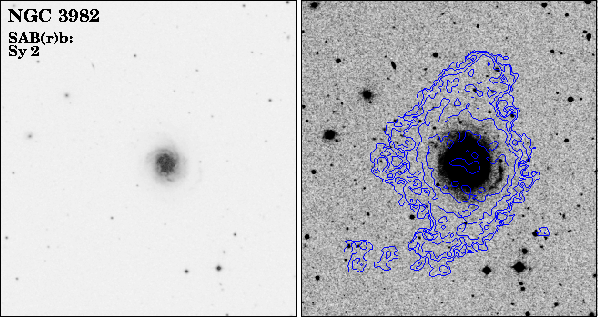
(Figure 12: The NGC 3982 System.
HI: VLA C-array, 17.6" x 16.6" resolution,
contours=5
x 1019
cm-2
x 2n.
Optical: DSS, FOV=9' x 10'.
Notes: Member of the Ursa Major Cluster
(Fig. 164).
See Fig. 135
for a lower-resolution image.
Reference: Mundell, these proceedings,
p. 411.)
The Arp 214 / NGC 3718 system

(Figure 13: The NGC 3718 System.
HI: WSRT, 30'' resolution, contours=2
x 1020
cm-2
x 2n.
Optical: DSS, FOV=20' x 19'.
Notes: Member of the Ursa Major Cluster. See
also Fig. 164.
Reference: Verheijen, M. A. W., & Sancisi,
R. 2001, A&A 370, 765.)
The blue compact dwarf UGC 521 system

(Figure 14: The Blue Compact Dwarf UGC 521.
HI: VLA CS-array, 19" x 17.4" resolution,
contours=8
x 1019
cm-2
x 2n.
Optical: Left: DSS. Right: KPNO 0.9m B-band.
FOV=5' x 7'.
Reference: van Zee & Haynes, these
proceedings, p. 865.)
The NGC 4013 system

(Figure 15: The NGC 4013 System.
HI: WSRT, 30'' resolution, contours=1
x 1020
cm-2
x 2n.
Optical: DSS, FOV=11' x 11'.
Notes: Member of the Ursa Major Cluster.
Reference: Bottema, R. 1995, A&A, 295, 605,
and Verheijen, M. A. W., & Sancisi, R. 2001, A&A
370, 765.)
The IC 5078 system

(Figure 16: The IC 5078 System.
HI: VLA D-array, 108.3" x 51.5" resolution,
contours=3
x 1019
cm-2
x 2n.
Optical: WIYN R-band, FOV=12' x 8'.
Reference: Pisano & Wilcots, these
proceedings, p. 501.)
The NGC 895 system

(Figure 17: The NGC 895 System.
HI: VLA D-array, 76'' resolution, contours=2
x 1019
cm-2
x 2n.
Optical: WIYN R-band, FOV=14' x 15'.
Reference: Pisano & Wilcots, these
proceedings, p. 501.)
The NGC 3885 system

(Figure 18: The NGC 3885 System.
HI: VLA D-array, 60'' resolution, contours=4
x 1019
cm-2
x 2n.
Optical: DSS, FOV=15' x 15'.
Notes: The companion galaxy has no cataloged
counterpart.
Reference: Hameed & Young, these
proceedings, p. 857.)
The UGC 8331 system

(Figure 19: The UGC 8331 System.
HI: WSRT, 30'' resolution, contours=1
x 1020
cm-2
x 2n.
Optical: DSS, FOV=8' x 9'.
Reference: Swaters, R. A., 1999, PhD thesis,
Rijksuniversiteit Groningen, and Swaters, R.A., van
Albada, T.S., van der Hulst, J.M., & Sancisi, R.,
2001, A&AS submitted.)
The UGC 11152 system

(Figure 20: The UGC 11152 System.
HI: VLA D-array, 66'' resolution, contours=3
x 1019
cm-2
x 2n.
Optical: WIYN B-band, FOV=8' x 6'.
Reference: Pisano & Wilcots, these
proceedings, p. 501.)
The NGC 4639 / 4654 system
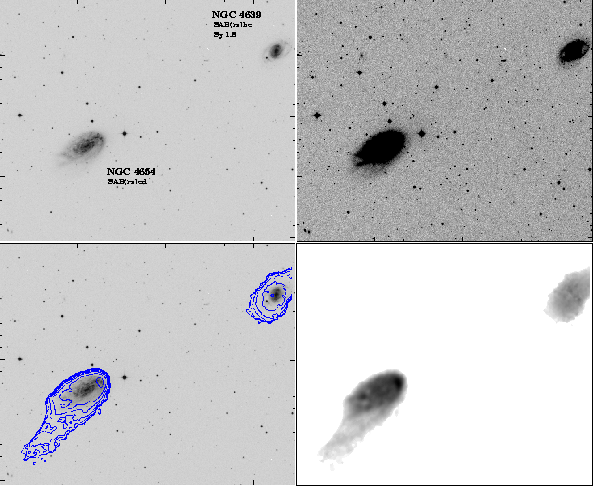
(Figure 21: The NGC 4639 / 4654 System.
HI: VLA C+D-array, 27.5" x 23.5" resolution,
contours=4
x 1019
cm-2
x 2n.
Optical: DSS, FOV=24' x 20'.
Reference: Phookun, B., & Mundy, L. G.
1995, ApJ 453, 154.)
The ESO 572-G045 system

(Figure 22: The ``Superthin'' galaxy ESO 572-G045.
HI: VLA C+D-array. Left panel: 40'' resolution,
contours=1
x 1020
cm-2
x 2n/2.
Middle panel: 27" x 16" resolution, contours=1
x 1020
cm-2
x 2n/2.
Right panel: 11" x 7.4" resolution, contours=4
x 1020
cm-2
x 2n.
Optical: DSS, FOV=2.9' x 3.5'.
Notes: Companion to the merging system
NGC4038/9 (see Fig. 65).
Reference: Hibbard, J.E., van der Hulst, J. M.,
Barnes, J. E., & Rich, R. M. 2001, AJ in
press.)
The IC 3355 system

(Figure 23: The IC 3355 System.
HI: VLA D-array, 58" x 48" resolution,
contours=2
x 1019
cm-2
x 2n.
Optical: DSS, FOV=8' x 7'.
Notes: Member of the Virgo cluster near M86.
See also Fig. 167.
Reference: Observed in the field of NGC 4406
(M86) by Li & van Gorkom, these proceedings,
p. 637.)
The NGC 4522 system

(Figure 24: The NGC 4522 System.
HI: VLA C-array, 19.7" x 15.5" resolution,
contours=1
x 1020
cm-2
x 2n.
Optical: DSS, FOV=4' x 5'.
Reference: Kenney, van Gorkom, & Vollmer,
these proceedings, p. 861.)
The Arp 120 system

(Figure 25: The Arp 120 System.
HI: VLA D-array, 58" x 48" resolution,
contours=2
x 1019
cm-2
x 2n.
Optical: DSS, FOV=10' x 13'.
Notes: Member of the Virgo cluster near M86.
See also Fig. 167.
Reference: Observed in the field of NGC 4406
(M86) by Li & van Gorkom, these proceedings,
p. 637.)
The NGC 3079 system

(Figure 26: The NGC 3079 System.
HI: VLA D-array, contours=(0.5, 1, 1.5, 2.4, 4,
10, 15, 25, 45)
x 1020
cm-2.
Resolution: 48" x 40" NGC 3079; 67" x 57" others.
Optical: DSS, FOV=19.2' x 17.8'.
Reference: Irwin, J.A., Seaquist, E.R., Taylor,
A.R., & Duric, N. 1987, ApJ 313,
L91.)
The blue compact dwarf Arp 266 / NGC 4861 system

(Figure 27: The Blue Compact Dwarf NGC 4861.
HI: VLA C-array. Lower panels: contours at 5
x 1019
cm-2
x 2n,
19" x 15" resolution. Lower right: at 35'' resolution,
greyscales range from
5 x 1019
- 2 x 1020
cm-2.
Optical: DSS, FOV=7.0' x 7.2' (top), 10.8' x
9.6' (lower right).
Notes: The low resolution data reveal an
extended envelope and an companion which has no
apparent counterpart on the DSS image.
Reference: Thuan, Hibbard & Levrier, these
proceedings, p. 864.)
The ESO 124-G015 system

(Figure 28: The ESO 124-G015 System.
HI: ATCA, 58.3' x 54.5" resolution, contours=5
x 1019
cm-2
x 2n.
Optical: B-band, FOV=8' x 7'.
Reference: Pisano & Wilcots, these
proceedings, p. 501.)
The NGC 3359 system
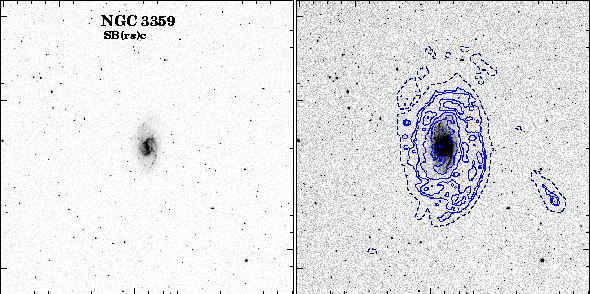
(Figure 29: The NGC 3359 System.
HI: WSRT. Solid contours: 30'' resolution,
levels=3
x 1019
cm-2
x 2n.
Dotted contour: 60'' resolution, 5
x 1018
cm-2.
Optical: DSS, FOV=35.0' x 35'2'.
Reference: Boonyasait, Gottesman & Broeils,
these proceedings, p. 856.)
The M108 system

(Figure 30: The M108 System.
HI: VLA D-array, 61" x 53" resolution,
contours=1
x 1019
cm-2
x 2n.
Optical: DSS, FOV=24' x 11'.
Notes: The redshift of MCG+09-19-001 is
unknown.
Reference: King, D., & Irwin, J. A. 1997, New
Astronomy, 2, 251.)
The NGC 6239 system

(Figure 31: The NGC 6239 System.
HI: VLA D-array, 18.2" x 16.7" resolution,
contours=8
x 1019
cm-2
x 2n.
Optical: DSS, FOV=17' x 12'.
Notes: The companion to the northeast has no
cataloged counterpart.
Reference: Hogg & Roberts, these
proceedings, p. 858.)
The NGC 1012 system

(Figure 32: The NGC 1012 System.
HI: VLA D-array, 19.7" x resolution, contours=8
x 1018
cm-2
x 2n.
Optical: DSS, FOV=13' x 16'.
Reference: Hogg & Roberts, these
proceedings, p. 858.)
The NGC 2777 system
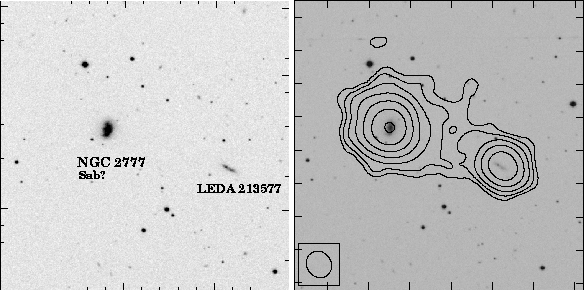
(Figure 33: The Amorphous Galaxy NGC 2777.
HI: VLA D-array, 52" x 47" resolution,
contours=2;25
x 1019
cm-2
x 2n.
Optical: DSS, FOV=8.9' x 8.8'.
Notes: The SA(r)ab galaxy NGC 2775 lies 10' to
the south, and was also detected in the observations.
It has a regular disk-like distribution.
Reference: Hogg, D. E., Roberts, M. S.,
Schulman, E., & Knezek, P. M. 1998, AJ 115,
502.)
The Arp 31 System

(Figure 34: The Arp 31 System.
HI: VLA D-array, 56'',
contours=(1.4,4.1,12.3,27.3, 61.6)
x 1019
cm-2.
Optical: DSS, FOV=8' x 13'.
Notes: Members of the NGC691 group. See
Fig. 158.
Reference: van Moorsel, G. A., 1988, A&A
202, 59.)
The Arp 5 system

(Figure 35: The One-Armed Spiral NGC 3664.
HI: VLA D-array, 50" x 43" resolution,
contours=4
x 1019
cm-2
x 2n.
Optical: DSS, FOV=9' x 13'.
Reference: Wilcots, E., & Prescott, M.K.,
AJ 2001, submitted.)
The Arp 22 system

(Figure 36: The Arp 22 System.
HI: VLA C-array, 26" x 18" resolution,
contours=1
x 1020
cm-2
x 2n.
Optical: DSS, FOV=8' x 9'.
Reference: Phookun, B., Mundy, L. G., Teuben,
P., Wainscoat, R. J. 1992, ApJ 400,
516.)
The UGC 5272 system

(Figure 37: The UGC 5272 System.
HI: WSRT, 30'' resolution, contours=1
x 1020
cm-2
x 2n.
Optical: DSS, FOV=5.0' x 5.3'.
Reference: Swaters, R. A., 1999, PhD thesis,
Rijksuniversiteit Groningen, and Swaters, & R.A.,
van Albada, T.S., van der Hulst, J.M., Sancisi, R.,
2001, A&AS submitted.)
The Arp 78 system
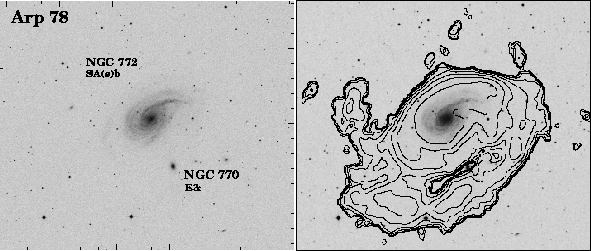
(Figure 38: The Arp 78 System.
HI: VLA D-array, 54" x 52" resolution,
contours=4.4
x 1020
cm-2
x 2n.
Optical: DSS, FOV=19' x 16'.
Notes: The two galaxies are at approximately
the same redshift.
Reference: Iyer et al., these
proceedings, p. 860.)
The NGC 3471 system
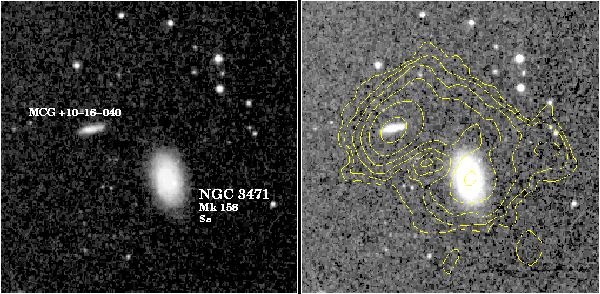
(Figure 39: The NGC 3471 System.
HI: VLA D-array, 60'' resolution, contours=4
x 1019
cm-2
x 2n.
Optical: DSS, FOV=8' x 7'.
Reference: Hameed & Young, these
proceedings, p. 857.)
The Arp 304 system
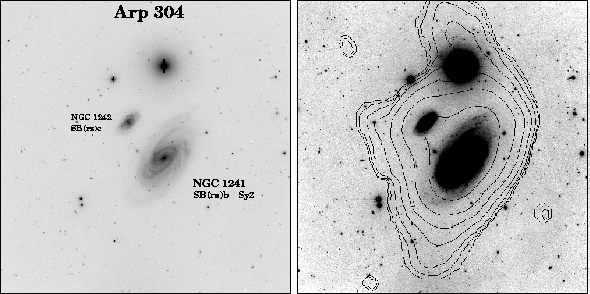
(Figure 40: The Arp 304 System.
HI: VLA D-array, 80'' resolution, contours=1
x 1019
cm-2
x 2n.
Optical: Palomar 5m Gunn r, FOV=10' x
10'.
Reference: Nordgren, T. E., Chengalur, J. N.,
Salpeter, E. E., & Terzian, Y. 1997, AJ 114,
913).
The Arp 206 system

(Figure 41: The Arp 206 System.
HI: WSRT, 30'' resolution, contours=2
x 1020
cm-2
x 2n.
Optical: DSS, FOV=12' x 14'.
Reference: Swaters, R. A., 1999, PhD thesis,
Rijksuniversiteit Groningen, and Swaters, R.A., van
Albada, T.S., van der Hulst, J.M., & Sancisi, R.,
2001, A&AS submitted.)
The Arp 280 system

(Figure 42: The Arp 280 System.
HI: VLA C+D-array, 23" x 22" resolution,
contours=7
x 1019
cm-2
x 2n.
Optical: DSS, FOV=11' x 13'.
Notes: Member of the Ursa Major Cluster. See
also Fig. 164.
Reference: Clemens, M. S., 1998, Ph.D. Thesis,
Cambridge University.)
The UGC 260 system

(Figure 43: The UGC 260 System.
HI: VLA D-array, 60'' resolution, contours=4
x 1019
cm-2
x 2n.
Optical: WIYN R-band, FOV=7' x 8'.
Reference: Pisano & Wilcots, these
proceedings, p. 501.)
The Arp 83 system

(Figure 44: The Arp 83 System.
HI: VLA D-array, 71" x 56" resolution,
contours=2
x 1019
cm-2
x 2n.
Optical: Palomar 5m Gunn r, FOV=7' x 7'
(left) 2.9' x 2.7' (right).
Reference: Nordgren, T. E., Chengalur, J. N.,
Salpeter, E. E., & Terzian, Y. 1997, AJ 114,
77.)
The Arp 279 system

(Figure 45: The Arp 279 System.
HI: Solid contours and lower right greyscale:
VLA C-array, 25" x 17" resolution, contours=2
x 1020
cm-2
x 2n.
Dotted contours: VLA D-array, 71'' resolution,
contours=(2, 4, 8)
x 1019
cm-2.
Optical: MSSSO 40'' R-band, FOV=13' x
12'.
Reference: Clemens, M. S., & Alexander, P.
2001, MNRAS, 321, 103 (C-array data) and Nordgren, T.
E., Chengalur, J. N., Salpeter, E. E., & Terzian,
Y. 1997, AJ 114, 913 (D-array and
optical data).)
The Arp 84 system

(Figure 46: The Arp 84 System.
HI: VLA C+D-array, 18.4" x 17.7" resolution,
contours=1
x 1020
cm-2
x 2n.
Optical: DSS, FOV=8' x 9'.
Reference: Kaufman, M., Brinks, E., Elmegreen,
B.G., Elmegreen, D.M., Klaric, M., Struck, C.,
Thomasson, M., & Vogel, S. 1999, , 118,
1577.)
The Arp 269 system

(Figure 47: The Arp 269 System.
HI: VLA C+D-array, 38" x 33" resolution,
contours=5
x 1019
cm-2
x 2n.
Optical: DSS, FOV=30' x 30'.
Reference: Clemens, M. S., Alexander, P., &
Green, D. A. 1998, MNRAS 297, 1015.)
The NGC 7463 / 7464 / 7465 system

(Figure 48: The NGC 7463/4/5 System.
HI: VLA C-array, 22" x 17", contours=(2.5, 6,
9, 12, 27)
x 1020
cm-2.
Optical: Top two panels: DSS. Bottom: Issac
Newton Telescope B-band. FOV=8' x 6'.
Notes: NGC 7463 is also detected in , but this
emission is not shown here.
Reference: Thomas et al., these
proceedings, p. 224.)
The Arp 82 system

(Figure 49: The Arp 82 System.
HI: VLA C+D-array, 16.7" x 16" resolution,
contours=2
x 1020
cm-2
x 2n.
Optical: DSS, FOV=7' x 7'.
Reference: Kaufman, M., Brinks, E., Elmegreen,
D.M., Thomasson, M., Elmegreen, B.G., Struck, C., and
Klaric, M. 1997, AJ 114, 2323.)
The NGC 3893 / 6 system

(Figure 50: The NGC 3893/6 System.
HI: WSRT, 30'' resolution, contours=1
x 1020
cm-2
x 2n.
Optical: DSS, FOV=10' x 10'.
Notes: Member of the Ursa Major Cluster. See
also Fig. 164.
Reference: Verheijen, M. A. W., & Sancisi,
R. 2001, A&A 370, 765.)
The M51 system

(Figure 51: M51, The Whirlpool Galaxy.
HI: VLA C+D-array, 34'' resolution, contours=4
x 1019
cm-2
x 2n.
Optical: DSS, FOV=24.4' x 27.4'.
Reference: Rots, A. H., Bosma, A., van der
Hulst, J. M., Athanassoula, E., & Crane, P. C.
1990, AJ, 100, 387. See also Miller,
Bregman & Wakker, these proceedings, p. 533.)
The Markarian 348 /
NGC 252 / 266 system

(Figure 52: The Mrk 348 System.
HI: Left: VLA D-array, 57'' resolution,
contours=5
x 1019
cm-2
x 2n.
Top right: VLA D-array, 44'' resolution, contours=1
x 1019
cm-2
x 2n.
Bottom right: VLA C-array, 13.6" x 12.8" resolution,
contours=1
x 1020
cm-2
x 2n.
Optical: Left: DSS, FOV=25' x 30'. Right: KPNO
0.9m B-band, FOV=5.1' x 3.7' (top), 5.6' x
5.2' (bottom).
Reference: Simkin S. M., van Gorkom, J. H.,
Hibbard, J. E., Hong-Jun, S. 1987, Science 235,
1367.)
The M81 / M82 / NGC 3077 system

(Figure 53: The M81 / M82 / NGC 3077 System.
HI: VLA D-array, 135" x 125" resolution,
contours=3
x 1019
cm-2
x 2n.
Optical: DSS. FOV=170' x 140' (M81), 18' x 17'
(NGC3077), 21' x 21' (M82).
Reference: Yun, M. S., Ho, P. T. P., & Lo,
K. Y. 1994, Nature 372, 530.)
The Arp 281 system

(Figure 54: The Arp 281 System.
HI: WSRT, 87" x 45" resolution, contours=2
x 1019
cm-2
x 2n.
Optical: DSS, FOV=42.6' x 41.5' (top).
Reference: Rand, R. J., & van der Hulst, J.
M. 1993, AJ 105, 2098.)
The Arp 18 system

(Figure 55: The Arp 18 System.
HI: WSRT, 30'' resolution, contours=2
x 1020
cm-2
x 2n.
Optical: DSS, FOV=13' x 20'.
Notes: Member of the Ursa Major Cluster. See
also Fig. 164.
Reference: Verheijen, M. A. W., & Sancisi,
R. 2001, A&A 370, 765.)
The NGC 1511 system

(Figure 56: The NGC 1511 System.
HI: ATCA 1.5 km configuration, 42'' resolution,
contours=5
x 1019
cm-2
x 2n.
Optical: MSSSO 40'' R-band, FOV=15' x
15'.
Reference: Nordgren, T. E., Chengalur, J. N.,
Salpeter, E. E., & Terzian, Y. 1997, AJ 114,
913)
The NGC 1097 system
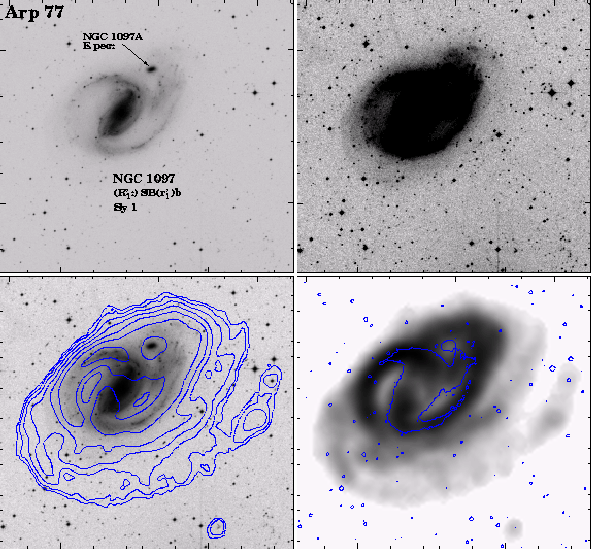
(Figure 57:
The NGC 1097 System.
HI: VLA
DnC-array, 56'' resolution, contours=3
x 1019
cm-2
x 2n.
Optical:
DSS, FOV=17.8' x 17.2'.
Reference: Higdon & Wallin, these
proceedings, p. 859)
The NGC 1097 system
(even though modest in appearance under close HI
imaging) actually, as we will discuss in chapters IX and X,
has a large cohort of apparently ejected anomalous
redshift compact objects.
The NGC 2708 / 09 system

(Figure 58: The NGC 2708/9 System.
HI: VLA D-array, 78'' resolution, contours=2
x 1019
cm-2
x 2n.
Optical: WIYN B-band, FOV=8.3' x 15.8'.
Reference: Pisano & Wilcots, these
proceedings, p. 501.)
The Arp 217 / NGC 3310 system
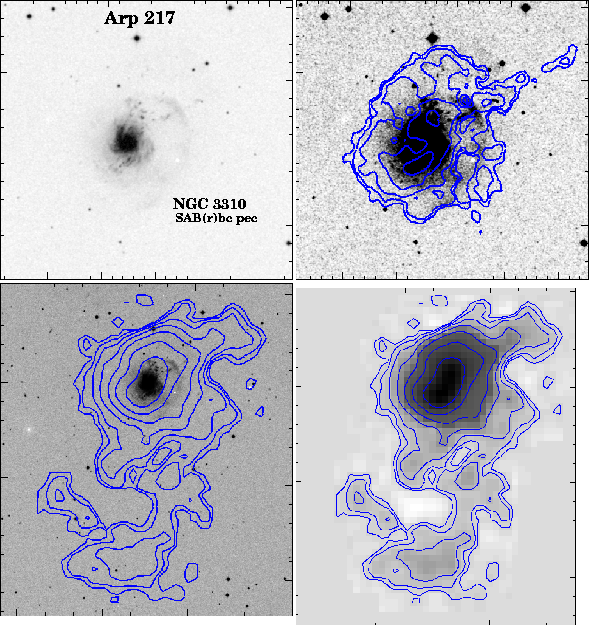
(Figure 59: The NGC 3310 System.
HI: WSRT. Upper right panel: 20'' resolution,
contours=2
x 1020
cm-2
x 2n.
Lower panels: 60'' resolution, contours=2
x 1019
cm-2
x 2n.
Optical: DSS, FOV=3.2' x 8.0' (top), 15.2' x
17.1' (bottom left).
Reference: Kregel, M. & Sancisi, R. 2001, A&A
in press.)
The Arp 215 / NGC 2782 system

(Figure 60: The NGC 2782 System.
HI: VLA B+C+D-array, 9.4" x 8.7" resolution,
contours=4
x 1020
cm-2
x 2n.
Optical: WYIN B-band, FOV=6.4' x 6.2'
(top).
References: Smith, B. J. 1994, AJ, 107,
1695 (data) and Jogee, S., Kenney, J. D. P., &
Smith, B. J. 1998, ApJ 494, L185
(Optical data).)
The NGC 2146 system

(Figure 61: The NGC 2146 System.
HI: Combined VLA D-array plus NRAO 300'
observations, 77" x 49" resolution, contours=3
x 1018
cm-2
x 2n.
Optical: DSS, FOV=16' x 16'.
Notes: The redshift of the nearby galaxy
NGC2146A lies outside of the passband of the
observations.
Reference: Taramopoulos, A., Payne, H., &
Briggs, F. H. 2001, A&A, 365, 360.)
The NGC 5713 / 5719 system

(Figure 62: The NGC 5713 / 5719 System.
HI: VLA C-array, 30'' resolution, contours=1
x 1020
cm-2
x 2n.
Optical: DSS, FOV=26' x 14'.
Reference: Langston & Teuben, these
proceedings, p. 861.)
The Arp 284 system
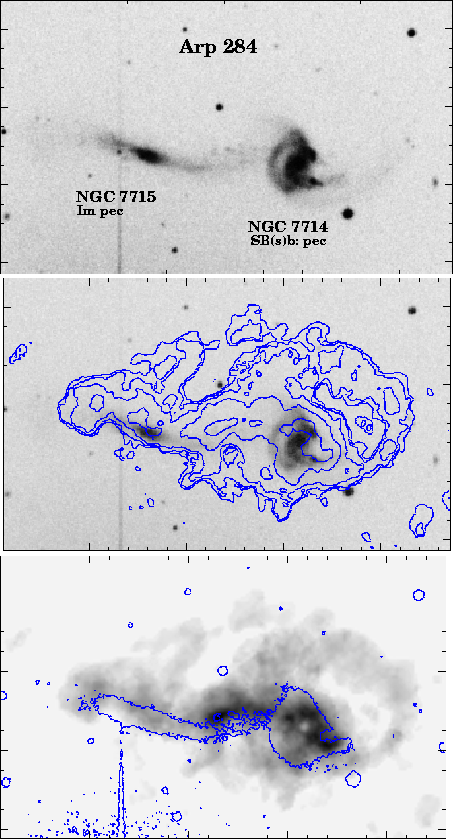
(Figure 63: The NGC 7714/15 System.
HI: VLA B+C+D-array, 11" x 8.5" resolution,
contours=2
x 1020
cm-2
x 2n.
Optical: DSS, FOV=6' x 3'.
Reference: Smith, B.J. 1991, ApJ, 393, 544 and
Smith, B.J., Struck, C., & Pogge, R.W. 1997, ApJ
483, 754.)
The Arp 245 system
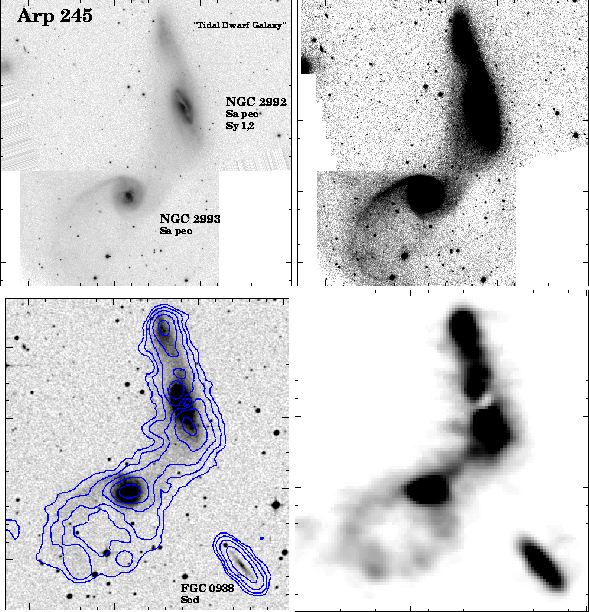
(Figure 64: The Arp 245 System.
HI: VLA CS-array, 25'' resolution, contours=1.1
x 1020
cm-2
x 2n.
Optical: Top: NTT+CFHT V-band. Bottom
left: DSS. FOV=8' x 8'.
Reference: Duc, P. -A., Brinks, E., Springel,
V., Pichardo, B., Weilbacher, P., & Mirabel, I.F.,
2000, AJ 120, 1238.)
The Arp 244 system

(Figure 65: The Toomre Sequence merger NGC 4038/9.
HI: VLA C+D-array, 40'' resolution, contours=4
x 1019
cm-2
x 2n.
Optical: DSS, FOV=17.2' x 23.7'.
Notes: The concentration at the end of the
southern tail is associated with a putative Tidal
Dwarf Galaxy. For a close-up of the companion galaxy
ESO 572-G045 see Fig. 22.
Reference: Hibbard, J.E., van der Hulst, J. M.,
Barnes, J. E., & Rich, R. M. 2001, AJ in
press.)
The Arp 242 system

(Figure 66: The Toomre Sequence merger NGC 4676.
HI: VLA C+D-array, 12'' resolution, contours=1
x 1020
cm-2
x 2n.
Optical: KPNO 2.1m B-band, FOV=3' x 5'.
Notes: There is an detected companion lying
12.8' to the south (NGC4676S) with no optical
counterpart visible on the DSS.
Reference: Hibbard, J. E. & van Gorkom, J.
H. 1996, AJ 111, 655.)
The Arp 263 system

(Figure 67: The Arp 263 System.
HI: VLA D-array, 64.3" x 54.6" resolution,
contours=5
x 1018
cm-2
x 2n.
Optical: DSS, FOV=15' x 14'.
Notes: The galaxies marked in parenthesis have
redshifts which place them in the background. CGCG
094-040 has no known redshift.
Reference: Iyer et al., these
proceedings, p. 860.)
The NGC 1487 system

(Figure 68: The NGC 1487 System.
HI: ATCA, 17'' resolution, contours=2
x 1020
cm-2
x 2n.
Optical: DSS, FOV=8.4' x 4.6'.
Reference: English & Freeman, these
proceedings, p. 857.)
The Arp 243 / NGC 2623 system

(Figure 69: The IR luminous Toomre Sequence
merger NGC 2623.
HI: VLA C+D-array. Middle panel: 16''
resolution, contours=4
x 1019
cm-2
x 2n.
Bottom panel: 21'' resolution, contours=3
x 1019
cm-2
x 2n.
Optical: Top and middle panels: UH 88'' R-band,
FOV=4.5' x 3.2'. Bottom panel: DSS, FOV=6' x 12'.
Reference: Hibbard, J.E., & Yun, M. S.
1996, in Cold Gas at High Redshift, eds.
M. Bremer, H. Rottgering, P. van der
Werf, & C. L. Carilli (Dordrecht: Kluwer),
47.)
The NGC 3256 system

(Figure 70: The Toomre Sequence merger NGC 3256.
HI: ATCA, 22.6'' resolution, contours=(2.2,
3.2, 4.3, 22, 43)
x 1019
cm-2.
Optical: Top panel: UH 88'' R-band.
Bottom panel: DSS, FOV=9' x 7'.
Notes: The nearby galaxies NGC 3256C, NGC 3262
and NGC 3263 were also detected in as part of these
observations.
Reference: English, J., Norris, R. P., Freeman,
K. C., & Booth, R. S. 2001, AJ in press.)
The Arp 193 system

(Figure 71: The IR luminous merger Arp 193.
HI: VLA C+D-array, 17" x 16" resolution,
contours=2
x 1019
cm-2
x 2n.
Optical: UH 88'' B-band, FOV=4.1' x
3.7'.
Reference: Hibbard, J.E., & Yun, M. S.
1996, in Cold Gas at High Redshift, eds.
M. Bremer, H. Rottgering, P. van der
Werf, & C. L. Carilli (Dordrecht: Kluwer),
47.)
The Arp 226 system
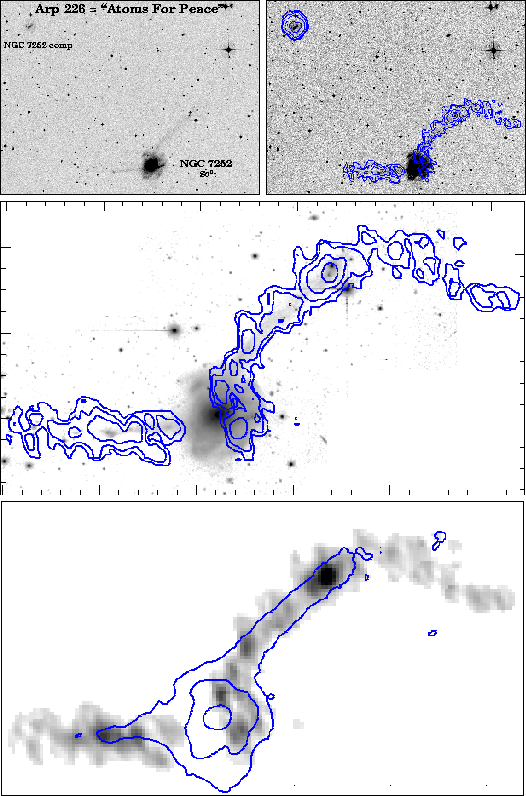
(Figure 72: The Toomre Sequence merger NGC7252.
HI: VLA C+D-array, 27" x 16" resolution,
contours=4
x 1019
cm-2
x 2n.
Optical: DSS, FOV=17.8' x 13.2' (top panels)
and CTIO 4m R-band, FOV= 9.3' x 6.0' (bottom
panels).
Notes: The bright clump in the northwest tail
is associated with a putative Tidal Dwarf Galaxy.
Reference: Hibbard, J.E., Guhathakurta, P., van
Gorkom, J. H., & Schweizer, F. 1994, AJ 107,
67.)
The LMC, SMC, and Megallanic Stream

(Figure 73: The Large and Small Magellanic Clouds
and the Magellanic Stream.
HI: Parkes Multibeam All-Sky Survey (see
Stavely-Smith et al., these proceedings,
p. 427), 15.5' resolution, contours=1
x 1019
cm-2
x 2n.
Optical: Image from the color imaging team at
Mt. Stromlo Observatory (see Bessell, M. 2000, PASA
17, 179).
Reference: Putman, M.E., et al., 1998,
Nature, 394, 752.)
The NGC 7769 / 7771 system

(Figure 74: The NGC 7769 / 7771 System.
HI: VLA D-array, 67" x 52" resolution,
contours=1
x 1019
cm-2
x 2n.
Optical: Top panels: Palomar 5m Gunn r,
FOV=10.9' x 8.0'. Bottom left panel: DSS, FOV=20' x
21'.
Reference: Nordgren, T. E., Chengalur, J. N.,
Salpeter, E. E., & Terzian, Y. 1997, AJ 114,
77.)
The Arp 270 system

(Figure 75: The Arp 270 System.
HI: VLA C+D-array, 21'' resolution, contours=1
x 1020
cm-2
x 2n.
Optical: DSS, FOV=6' x 4' (top), 16' x 19'
(bottom).
Reference: Clemens, M. S., Baxter, K. M.,
Alexander, P., & Green, D. A. 1999, MNRAS,
308, 364. See also Clemens, Winter, &
Alexander, these proceedings, p. 208.)
The NGC 6670A / B system

(Figure 76: The IR Luminous Merger NGC 6670.
HI: VLA C-array, 21" x 17" resolution,
contours=1
x 1020
cm-2
x 2n.
Optical: DSS, FOV=8' x 4'.
Reference: Wang, W.-H., Lo, K. Y., Gao, Y.,
& Gruendl, R. A. 2001, AJ 121,
140.)
The Arp 299 system

(Figure 77: The IR luminous merger Arp 299.
HI: VLA C+D-array. Lower left: 21'' resolution,
contours=4
x 1019
cm-2
x 2n.
Lower right: 35'' resolution. Optical: UH 88''
B-band, FOV=7' x 12'.
Notes: There is a small detected companion 10'
to the west of Arp 299.
Reference: Hibbard, J. E., & Yun, M. S.
1999, AJ 118, 162.)
The Arp 186 system

(Figure 78: The IR luminous merger NGC 1614.
HI: VLA C+D-array, 19'' resolution, contours=4
x 1019
cm-2
x 2n.
Optical: UH 88'' B-band, FOV=5.2' x
4.8' (top), 2.0' x 2.3' (bottom left).
Reference: Hibbard, J.E., & Yun, M. S.
1996, in Cold Gas at High Redshift, eds.
M. Bremer, H. Rottgering, P. van der
Werf, & C. L. Carilli (Dordrecht: Kluwer),
47.)
The NGC 3958 / 3963 system

(Figure 79: The NGC 3958 / 3963 System.
HI: WSRT, 60'' resolution, contours=2
x 1019
cm-2
x 2n.
Optical: Palomar 5m Gunn r, FOV=11.6' x
13.4'.
Reference: Nordgren, T. E., Chengalur, J. N.,
Salpeter, E. E., & Terzian, Y. 1997, AJ 114,
77.)
The UGC 6962 / 6973 system

(Figure 80: The UGC 6962 / 6973 System.
HI: WSRT, 30'' resolution, contours=1
x 1020
cm-2
x 2n.
Optical: DSS, FOV=9' x 7'.
Notes: Member of the Ursa Major Cluster. See
also Fig. 164.
Reference: Verheijen, M. A. W., & Sancisi,
R. 2001, A&A 370, 765.)
The NGC 3424 / 3430 system

(Figure 81: The NGC 3424 / 3430 System.
HI: VLA D-array, 83'' resolution, contours=1
x 1019
cm-2
x 2n.
Optical: DSS, FOV=30' x 27'.
Notes: NGC 3413 is a foreground object.
Reference: Nordgren, T. E., Chengalur, J. N.,
Salpeter, E. E., & Terzian, Y. 1997, AJ 114,
77.)
The NGC 5774 / 5 system
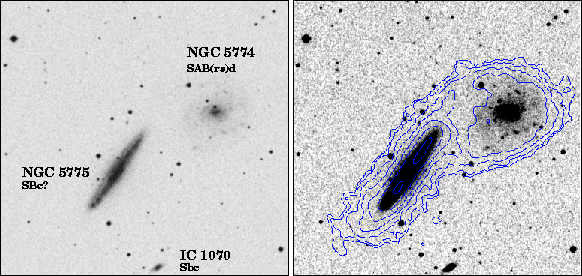
(Figure 82: The NGC 5774/5 System.
HI: VLA CnB-array, 29" x 23" resolution,
contours=1
x 1020
cm-2
x 2n.
Optical: DSS, FOV=11' x 10'.
Reference: Irwin, J. A. 1994, ApJ 429,
618.)
The NGC 672 / IC 1727 system

(Figure 83: The NGC 672/IC1727 System.
HI: VLA C-array, 18.5" x 16.6" resolution,
contours=1
x 1020
cm-2
x 2n.
Optical: DSS, FOV=19.7' x 19.1'.
Reference: Prescott & Wilcots, these
proceedings, p. 863.)
The NGC 2207 / IC 2163 system

(Figure 84: The NGC 2207 / IC 2163 System.
HI: VLA BnC-array, 13.5" x 12" resolution,
contours=3
x 1020
cm-2
x 2n.
Optical: DSS, FOV=7.1' x 7.1'.
Reference: Elmegreen, D.M., Kaufman, M.,
Brinks, E., Elmegreen, B.G., & Sundin, M. 1995, ApJ
453, 100.)
The Arp 271 system

(Figure 85: The Arp 271 System.
HI: VLA C+D-array, 35" x 27" resolution,
contours=4
x 1019
cm-2
x 2n.
Optical: DSS, FOV=15.6' x 11.0'.
Notes: The Arp 271 companion is associated with
a cataloged APMUKS object (B140004.67-054920.9). The
LCRS object has redshift only 10 km s−1
different
from Arp 271.
Reference: Clemens, M. S., 1998, Ph.D. Thesis,
Cambridge University.)
The Arp 298 system

(Figure 86: The Arp 298 System.
HI: VLA C-array, 20" x 18" resolution,
contours=4
x 1019
cm-2
x 2n.
Optical: DSS, FOV=5' x 5'.
Reference: Mundell, these proceedings,
p. 411)
The UGC 12914 / 5 system

(Figure 87: The UGC 12914/5 System.
HI: VLA C-array, 18'' resolution, contours=1
x 1020
cm-2
x 2n.
Optical: DSS, FOV=4.7' x 4.6'.
Reference: Condon, J. J., Helou, G., Sanders,
D. B., & Soifer, B. T. 1993, AJ 105,
1730.)
The ESO 343 / G014 / 7 system

(Figure 88: The ESO 353-G014/7 System.
HI: ATCA 1.5 km configuration, 41'' resolution,
contours=5
x 1019
cm-2
x 2n.
Optical: MSSSO 40'' R-band, FOV=5' x
8'.
Reference: Nordgren, T. E., Chengalur, J. N.,
Salpeter, E. E., & Terzian, Y. 1997, AJ 114,
913)
The NGC 7125 / 6 system
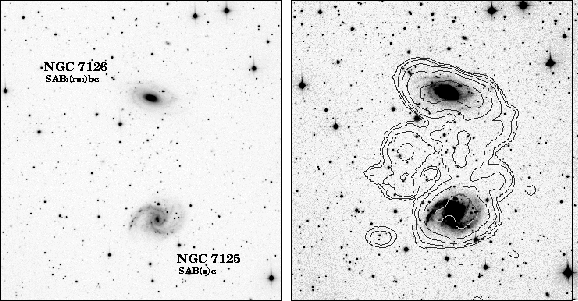
(Figure 89: The NGC 7125/6 System.
HI: ATCA 1.5 km configuration, 57'' resolution,
contours=4
x 1019
cm-2
x 2n.
Optical: MSSSO 40'' R-band, FOV=15' x
15'.
Reference: Nordgren, T. E., Chengalur, J. N.,
Salpeter, E. E., & Terzian, Y. 1997, AJ 114,
913)
The VV 785 system

(Figure 90: The Cartwheel Ring Galaxy System.
HI: VLA BnA+CnB+DnC-array. Contours: 29.6" x
20.8" resolution, levels 5
x 1019
cm-2
x 2n.
Greyscale: 8.1" x 6.9" resolution.
Optical: DSS, FOV=3.6' x 5.2'.
Reference: Higdon, J.L., 1996, ApJ 467,
241.)
The II Zw 70 / 71 system

(Figure 91: The Polar Ring Galaxy System VV 324
(II Zw 70/71).
HI: VLA C+D-array, 22.5" x 20" resolution.
Optical: Top two panels: DSS, FOV=6.5' x 4.6'.
Bottom panel: B-band image from OSU Imaging
Fabry-Pérot
Spectrometer.
Reference: Cox, A.L., Sparke, L.S., Watson,
A.M., & van Moorsel, G., 2001, AJ 121,
692.)
Morphologically similar or
somewhat comparable to VV324 (UGC 9560 / UGC 9562) in
the radio wavelengths is the directional / asymmetric
streaming activity from ESO 137-001 in both visible
(Hubble Space Telescope) and in X-ray (Chandra)
wavelengths (below).

Above: Streamers of star-formation
activity emerging from the galaxy as a "jelly-fish galaxy"
(visible light, Hubble);
Below: visible and X-ray illuminated star forming streamers
and hot gases (visible and X-ray composite; Hubble
& Chandra), forming a kind of wide jet.

The ESO 138-IG029 / ESO 138-IG030 system

(Figure 92: The "Sacred Mushroom'' Ring Galaxy
System.
HI: ATCA, 21.5" x 20.3" resolution, contours=5
x 1019
cm-2
x 2n.
Optical: DSS, FOV=5' x 5'.
Reference: Higdon et al., these
proceedings, p. 860.)
The VII Zw 466 system

(Figure 93: The Ring Galaxy System VII Zw 466.
HI: VLA C-array, 23" x 22" resolution,
contours=3
x 1019
cm-2
x 2n.
Optical: DSS, FOV=5.8' x 4.9'.
Reference: Appleton, P. N., Charmandaris, V.,
& Struck, C. 1996, ApJ 468, 532.)
The Arp 10 system

(Figure 94: The Ring(ed) Galaxy System Arp 10.
HI: VLA C-array, 21'' resolution, contours=4 x 1019 cm-2
x 2n.
Optical: DSS, FOV= 3.0' x 3.0' (top), 4,4' x
8.6' (bottom).
Reference: Charmandaris, V., & Appleton,
P.N., 1996, ApJ 460, 686.)
The AM 1354-250 system

(Figure 95: The Ring Galaxy System AM 1354-250.
HI: VLA CnB+DnC-array, 25" x 18" resolution,
contours=1 x 1020 cm-2 x 2n.
Optical: DSS, FOV=3.7' x 3.7'.
Reference: Higdon et al., these
proceedings, p. 859.)
The Arp 147 system

(Figure 96: The Ring Galaxy System Arp 147.
HI: VLA B-array, 6.5" x 6" resolution,
contours=3 x 1020 cm-2
x 2n.
Optical: DSS, FOV=1.4' x 1.4'.
Reference: Higdon et al., these
proceedings, p. 859.)
The Lindsay-Shapley Ring (VV 785) system

(Figure 97: The Lindsay-Shapley Ring.
HI: ATCA, 12.2" x 9.4" resolution, contours=2 x 1020
cm-2 x 2n.
Optical: DSS, FOV=3.6' x 4.3'.
Reference: Higdon et al., these
proceedings, p. 859.)
The NGC 2292 / 3 system

Figure 98: The NGC 2292/3 system.
HI: VLA D-array, 40" x 33" resolution,
contours=5 x 1019
cm-2 x 2n.
Optical: DSS, FOV=9.4' x 7.4' and 19' x 22'.
Notes: No was detected from NGC 2295 or ESO
490-GO42, even though they have velocities within the
range of the \ observations.
Reference: Rupen, Hibbard & Bunker, these
proceedings, p. 863.
The NGC 5506 / 7 system

(Figure 99: The NGC 5506/7 System.
HI: VLA C-array, 21.6" x 19.8" resolution,
contours=4
x 1019
cm-2
x 2n.
Optical: DSS, FOV=18' x 16'.
Notes: A lower resolution map of this system
showing more widely distributed gas is shown in
Fig. 151.
Reference: Mundell, these proceedings,
p. 411.)
The Arp 102 system

Figure 100: The Arp 102 System.
HI: VLA D-array, 52'' resolution, contours=(1,2,3,4,5,6,8,10,12,14,16)
x 1019
cm-2.
Optical: DSS, FOV=10' x 12'.
Reference: Higdon et al., these
proceedings, p. 859.
The Arp 104 system

Figure 101: The Arp 104 System.
HI: VLA D-array, 52'' resolution, contours=(1,2,3,4,5,6,8,10,12,14,16)
x 1019
cm-2.
Optical: DSS, FOV=11' x 12'.
Reference: Higdon et al., these
proceedings, p. 859.
The Arp 105 system

Figure 102: The
Arp 105 System.
HI: VLA C+D-array, 23" x 21" resolution,
contours=4.4
x 1019
cm-2
x 2n.
Optical: CFHT 4m V-band, FOV=4' x 6'.
Notes: In the cluster Abell 1185.
Reference: Duc, P. -A., Brinks, E., Wink, J.
E., & Mirabel, I. F. 1997, A&A 326,
537.
The Arp 143 system

Figure 103: The Ring
Galaxy NGC 2444/5.
HI: VLA C+D-array, 28'' resolution, contours=4
x 1019
cm-2
x 2n.
Optical: KPNO 0.9m B-band, FOV=13' x
17'.
Reference: Appleton, P. N., Ghigo, F. D, van
Gorkom, J. H., Schombert, J. M., & Struck-Marcell,
C. 1987, Nature 330, 140.
Arp 143 (= NGC 2444/5
= UGC 4016) is a complex system of galactic interactions the
imagery of which Hibbard provides a devoted link: https://www.cv.nrao.edu/~jhibbard/a143/a143.html
(also referenced in Appleton, P. N. & Struck-Marcell, C.
1996. Collisional ring galaxies. Fundamentals of Cosmic
Physics 16, 111-220. https://ned.ipac.caltech.edu/level5/Sept01/Appleton/frames.html).
In light of data discussed here and in other chapters, these
images may be considered as to their significance in
evaluating cosmological and cosmogonical models.
 Entry image in Arp's Atlas of Peculiar Galaxies (1966): https://ned.ipac.caltech.edu/level5/Arp/Figures/big_arp143.jpeg. |
True color RGB of B+V+R
passband filters: RGB false color image with green = optical and blue = HI radio: 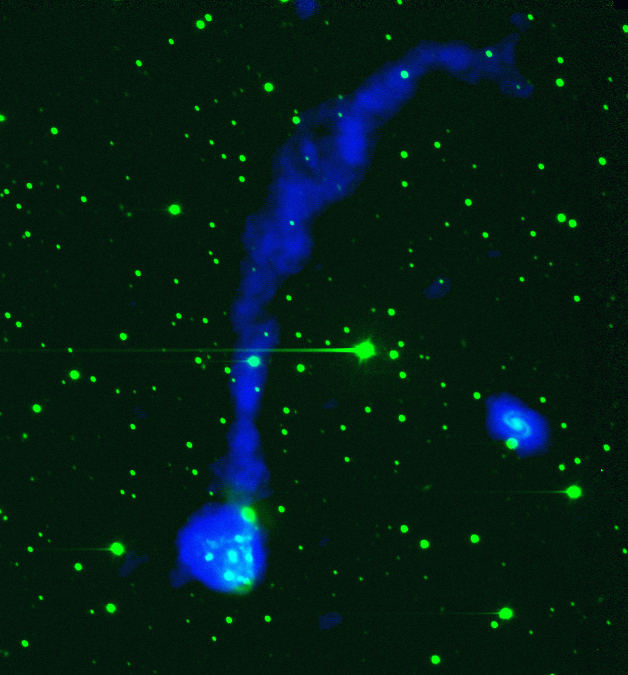 |
 |
 Left: True color smoothed in the blue violet red (BVR) photometric system of optical filters; Right (above): B & W smoothed image. |
HI contours stacked on top of
the B+V+R passband filtered image:

Tail detail:

The radio data
represented in the images were obtained at the VLA by
Appleton, P., Ghigo, F., van Gorkom, J. et al. 1987. A
giant intergalactic H I bubble near Arp l43. Nature 330,
140-142. https://doi.org/10.1038/330140a0,
including a later erratum: https://www.nature.com/articles/330500a0.
The NED database entry contains the data on 11 objects within
the Arp 143 entry angular location, including their redshifts,
whether considered to be close enough to be associated: https://ned.ipac.caltech.edu/cgi-bin/nph-objsearch?objname=Arp+143.
The erratum-linked imagery and the NED entry summary
data:
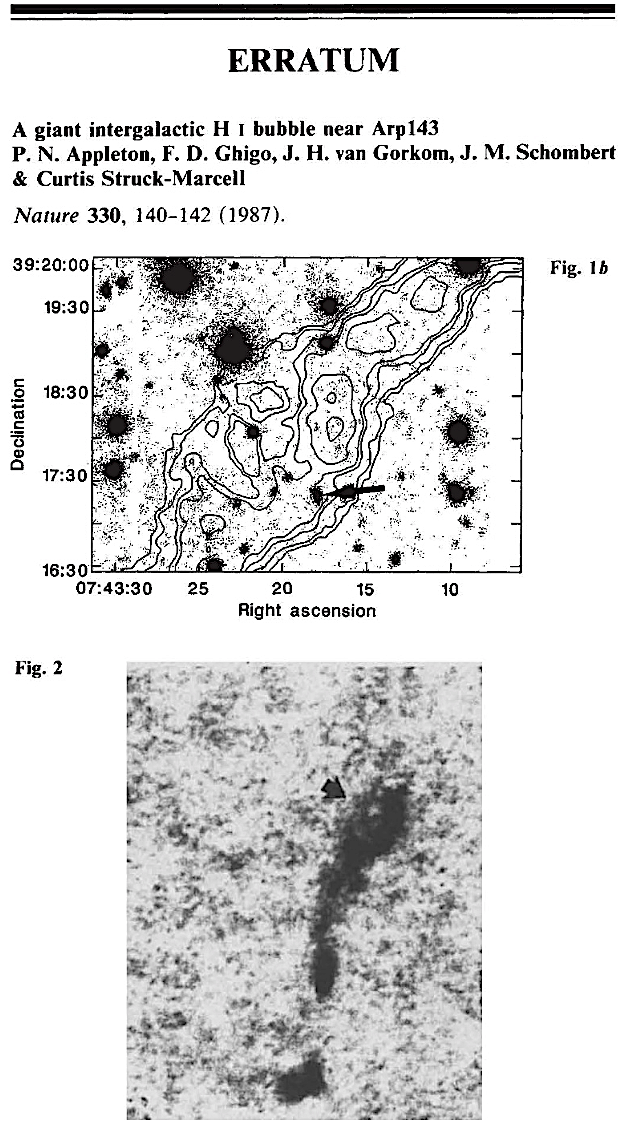 |
  |
The Arp 94 system

Figure 104: The Arp
94 System.
HI: VLA D-array, 80" x 47" resolution,
contours=1
x 1019
cm-2
x 2n.
Optical: DSS, FOV=8' x 11' (left) and 10' x 27'
(right).
Reference: Mundell, these proceedings,
p. 411.
The Mrk 273 system

Figure 105: The IR
luminous merger Mrk 273.
HI: VLA CnB-array, 16" x 14.3" resolution,
contours=1
x 1020
cm-2
x 2n.
Optical: Lower Right: DSS, FOV=16' x 19'. Other:
UH 88'' R-band, FOV=2.5' x 2.8'.
Notes: was also detected in UGC8707 and the
companion to the north.
Reference: Hibbard, J.E., & Yun, M. S.
1996, in Cold Gas at High Redshift, eds.
M. Bremer, H. Rottgering, P. van der
Werf, & C. L. Carilli (Dordrecht: Kluwer),
47.
The Arp 224 / NGC 3921 system

Figure 106: The
Toomre Sequence merger NGC3921.
HI: VLA C+D-array, 20'' resolution, contours=3
x 1019
cm-2
x 2n.
Optical: KPNO 2.1m R-band, FOV=7' x 9'
(top), 4' x 5' (bottom).
Notes: MCG+09-19-213 falls on the edge of the
passband of the observations, so is not completely
mapped in HI.
Reference: Hibbard, J. E., & van Gorkom, J.
H. 1996, AJ 111, 655.
The Arp 236 = VV 114 system

Figure 107: The
IR luminous merger VV 114.
HI: VLA C+D-array, 21" x 17" resolution,
contours=8
x 1019
cm-2
x 2n.
Optical: UH 88'' R-band, FOV=4' x 3'
(top), 10' x 8' (bottom).
Notes: Both IC1622 and ESO 541-G021 fall at the
edge of the passband of the observations, so are not
completely mapped in HI.
Reference: Hibbard, J.E., & Yun, M. S.
1996, in Cold Gas at High Redshift, eds.
M. Bremer, H. Rottgering, P. van der
Werf, & C. L. Carilli (Dordrecht: Kluwer),
47.
The Arp 158 system

Figure 108: The Arp
158 System.
HI: VLA D-array, 56" x 48" resolution,
contours=5
x 1018
cm-2
x 2n.
Optical: DSS, FOV=8' x 8'.
Reference: Iyer et al., these
proceedings, p. 860.
The NGC 6240 system
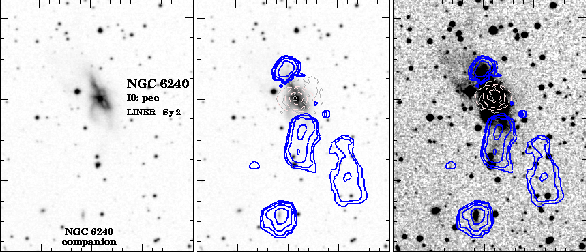
Figure 109: The IR
luminous merger NGC 6240.
HI: VLA C+D-array, 25'' resolution, contours=5
x 1019
cm-2
x 2n.
Optical: DSS, FOV=5' x 6'.
Notes: The companion to the south has no
cataloged counterpart.
Reference: Yun & Hibbard, these
proceedings, p. 866.
The NGC 520 system

Figure 110: The Toomre Sequence merger NGC520.
HI: VLA C+D-array, 24'' resolution, contours=3
x 1019
cm-2
x 2n.
Optical: KPNO 0.9m V-band, FOV=16' x
20'.
Notes: The nearby dwarf UGC957 is found to be
fully entrained within the extended ring.
Reference: Hibbard, J. E., & van Gorkom, J.
H. 1996, AJ 111, 655.
The Arp 220 system

Figure 111: The IR luminous merger Arp 220.
HI: VLA C+D-array. Upper right: 30''
resolution, contours=2
x 1019
cm-2
x 2n.
Lower left: 20'' resolution, contours=5
x 1019
cm-2
x 2n.
Optical: Upper panels: UH 88'' R-band,
FOV=7' x 6'. Lower panels: DSS, FOV=16' x 10' (right)
3' x 3' (left).
Notes: The dotted boxes in the lower right
panel delineate the regions shown in the other panels.
IC 4554 is at a higher redshift than Arp 220, so
presumably a background galaxy. The companion to the
northeast has no cataloged counterpart.
Reference: Yun & Hibbard, these proceedings
p. 866. See also Hibbard, J. E., Vacca, W. D.,
& Yun, M. S. 2000, AJ 119, 1130.




 |
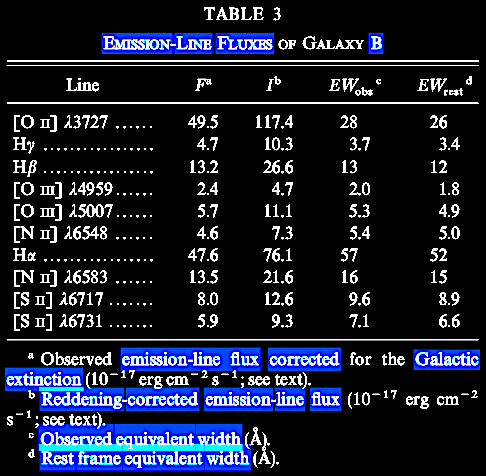  |
 |
 |

The NGC 7135 system

(Figure 112: The NGC7135 System.
HI: VLA C+D-array, 60.4" x 43.2" resolution,
contours=2
x 1019
cm-2
x 2n.
Optical: DSS, FOV=16' x 16'.
Reference: Schiminovich et al., these
proceedings, p. 863.)
The NGC 5018 system

(Figure 113: The NGC5018 System.
HI: VLA D-array, 60'' resolution, contours=3
x 1019
cm-2
x 2n.
Optical: DSS, FOV=28' x 26'.
Reference: Kim, D. -W., Guhathakurta, P., van
Gorkom, J. H., Jura, M., & Knapp, G. R. 1988, ApJ
330, 684.)
The Arp 227 system

(Figure 114: The Arp 227 Shell System.
HI: VLA D-array, 49" x 46" resolution,
contours=1
x 1019
cm-2
x 2n.
Optical: DSS, FOV=17' x 20'.
Notes: The lower right panel shows an expanded
field of view, showing an detected companion to the
south. The dotted box shows the region imaged in the
other three panels.
Reference: Schiminovich et al., these
proceedings, p. 863.)
The Fornax A system

(Figure 115: The Fornax A System.
HI: VLA DnC-array, 53.7" x 42.6" resolution,
contours=2
x 1019
cm-2
x 2n.
Optical: DSS, FOV=33' x 27'.
Reference: Horellou, C., Black, J. H., van
Gorkom, J. H., Combes, F., van der Hulst, J. M., &
Charmandaris, V. 2001, A&A submitted.)
The NGC 4125 system

(Figure 116: The Peculiar Elliptical NGC 4125.
HI: VLA D-array, 160" x 40" resolution,
contours=2
x 1019
cm-2
x 2n.
Optical: DSS, FOV=7.3' x 6.9'.
Reference: Rupen, Hibbard & Bunker, these
proceedings, p. 863.)
The NGC 7619 / 7626 system
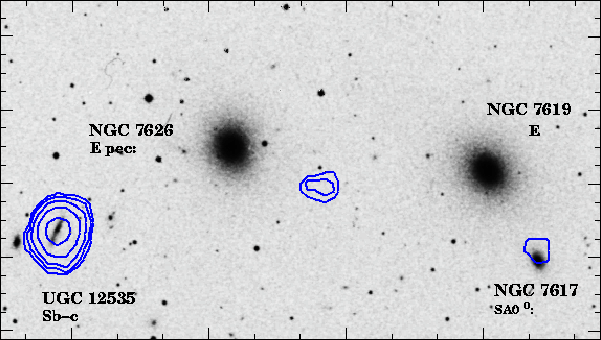
(Figure 117: The NGC 7619/7626 System.
HI: VLA D-array, 54" x 50" resolution,
contours=1
x 1019
cm-2
x 2n.
Optical: DSS, FOV=17' x 10'.
Notes: The central galaxies of the Pegasus I
group in the Pegasus Cluster—see also Fig. 166.
Reference: Observations centered on NGC7626:
Hibbard & Sansom, these proceedings, p. 858.
Observations centered on NGC7617: Schiminovich et
al., these proceedings, p. 863.)
The M86 region system

(Figure 118: The M86 Region.
HI: VLA D-array, 58" x 48" resolution,
contours=2
x 1019
cm-2
x 2n.
Optical: DSS, FOV=27' x 23'.
Notes: Member of the Virgo cluster. See also
Fig. 167.
Reference: Li & van Gorkom, these
proceedings, p. 637.)
The M85 system

(Figure 119: The M85 System.
HI: VLA D-array, 54" x 50" resolution,
contours=3
x 1019
cm-2
x 2n.
Optical: DSS, FOV=22' x 18'.
Reference: Hibbard & Sansom, these
proceedings, p. 858.)
The HI radio-silent Ellipticals

(Figure 120: Peculiar Early Types Undetected in
Radio.
HI: upper limits are in the range of a few 107.
See Sansom, A.E., Hibbard, J.E., & Schweizer, F.,
2001, AJ 120, 1946.
Optical: DSS. Notes: For each system,
the value of the Fine Structure Index (FSI), a
quantitative measure of optical morphological
peculiarity, is listed. See Schweizer, F., &
Seitzer, P. 1992, AJ 104, 1039.
Reference: NGC3610, NGC3640 and NGC5322:
Hibbard & Sansom, these proceedings, p. 858.
NGC596, NGC7585 and NGC7600: Schiminovich et al.,
these proceedings, p. 863.)
The NGC 678 / 680 system

(Figure 121: The NGC 678/680 System.
HI: VLA D-array, 56'', contours=(1.4, 4.1,
12.3, 27.3, 61.6) x 1019
cm-2.
Optical: DSS, FOV=15' x 11'.
Notes: Members of the NGC691 group. See
Fig. 158.
Reference: van Moorsel, G. A., 1988, A&A
202, 59.)
The Mrk 315 system

(Figure 122: Mrk 315.
HI: VLA C-array, 15.6" x 14.7" resolution,
contours=1
x 1020
cm-2
x 2n.
Optical: DSS, FOV=3' x 3'.
Reference: Simkin, these proceedings,
p. 408.)
The NGC 2534 system

(Figure 123: The Peculiar Elliptical NGC 2534.
HI: VLA D-array, 67" x 51" resolution,
contours=2 x 1019
cm-2
x 2n.
Optical: DSS, FOV=6' x 6'.
Reference: Schiminovich et al., these
proceedings, p. 863.)
The NGC 1210 system

(Figure 124: The Shell Galaxy NGC 1210.
HI: VLA C+D-array, 52" x 36" resolution,
contours=4 x 1019
cm-2
x 2n.
Optical: Left: DSS. Upper right: deep optical
image from David Malin. FOV=7.0 x 5.7'.
Reference: Schiminovich et al., these
proceedings, p. 863.)
The Arp 155 system

(Figure 125: The Shell Galaxy NGC 3656.
HI: VLA C+D-array, 25.2" x 19.7" resolution,
contours=2 x 1019
cm-2
x 2n.
Optical: DSS, FOV=5' x 4'.
Notes: Part of the NGC3656 field—see Fig. 161.
Reference: Balcells, M., van Gorkom, J.H.,
Sancisi, R., & del Burgo, C. 2001, AJ in
press.)
The NGC 2865 system

(Figure 126: The Shell Galaxy NGC 2865.
HI: VLA B+C-array, 20'' resolution, contours=3
x 1019
cm-2
x 2n.
Optical: DSS, FOV=10' x 12'.
Reference: Schiminovich, D., van Gorkom, J. H.,
van der Hulst, J. M., & Malin, D. F. 1995, ApJ
444, L77. See also Schiminovich, these
proceedings, p. 147.)
The Arp 153 / Centaurus A systm

(Figure 127: The Centaurus A System.
HI: VLA D-array, 78" x 41" resolution,
contours=4
x 1019
cm-2
x 2n.
Optical: DSS, FOV=30' x 30'.
Reference: Schiminovich, D., van Gorkom, J. H.,
van der Hulst, J. M., & Kasow, S. 1994, ApJ
423, L101.)
The Arp 230 system

(Figure 128: The Shell Galaxy Arp 230.
HI: VLA B+C-array, 15'' resolution, contours=1
x 1020
cm-2
x 2n.
Optical: DSS, FOV=5' x 5'.
Reference: Schiminovich, D., van Gorkom, J.H.,
& van der Hulst, J.M., 2001, AJ submitted.
See also Schiminovich, these proceedings, p. 147.)
The MCG-05-07-001

(Figure 129: The Polar Ring Galaxy MCG-05-07-001.
HI: VLA B+C-array, 32.1" x 15.2" resolution,
contours=4
x 1019
cm-2
x 2n.
Optical: DSS, FOV=6' x 6'.
Reference: Schiminovich, D., van Gorkom, J.H.,
& van der Hulst, J.M., 2001, AJ submitted.
See also Schiminovich, these proceedings, p. 147.)
The UGC 7576 system

(Figure 130: The Polar Ring Galaxy UGC 7576.
HI: VLA C-array, 10'' resolution.
Optical: Top: DSS. Bottom: WIYN V-band
image, FOV=1.8' x 1.3'.
Reference: Cox, A.L., & Sparke, L.S. 1996,
ASP Conf.\ Ser. 106, The Minnesota Lectures on
Extragalactic Neutral Hydrogen, ed. E.D.
Skillman (ASP, SF), 168.)
The IC 2006 system
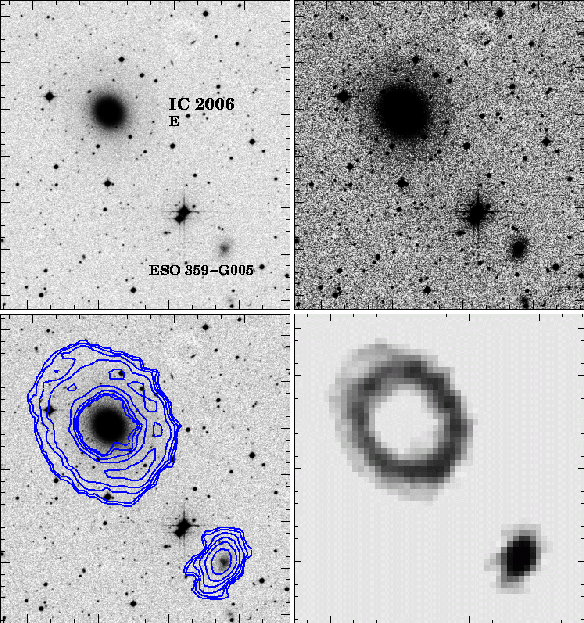
(Figure 131: The IC 2006 System.
HI: VLA D-array, 40'' resolution, contours=1
x 1019
cm-2
x 2n.
Optical: DSS, FOV=13' x 13'.
Reference: Franx, M., van Gorkom, J. H., &
de Zeeuw, P. T. 1994, ApJ, 436, 642
and Schweizer, F., van Gorkom, J. H., & Seitzer,
P. 1989, ApJ 338, 770.)
The NGC 2810 system

(Figure 132: The NGC 2810 System.
HI: VLA D-array, 64.4" x 48.5" resolution,
contours=1
x 1019
cm-2
x 2n.
Optical: DSS, FOV=6' x 7' (top), 19' x 23'
(bottom).
Reference: Schiminovich et al., these
proceedings, p. 863.)
The NGC 2768 system

(Figure 133: The NGC 2768 System.
HI: VLA D-array, 58" x 50" resolution,
contours=2
x 1019
cm-2
x 2n.
Optical: DSS, FOV=19' x 15'.
Reference: Schiminovich et al., these
proceedings, p. 863.)
The NGC 4026 system

(Figure 134: The NGC 4026 System.
HI: VLA D-array, 45'' resolution, contours=2
x 1019
cm-2
x 2n.
Optical: DSS, FOV=38' x 38'.
Notes: One of the three brightest lenticulars
in the Ursa Major cluster, all of which show disturbed
HI.
Reference: Verheijen & Zwaan, these
proceedings, p. 866.)
The NGC 3998 system

(Figure 135: The NGC 3998 System.
HI: VLA D-array, 45'' resolution, contours=2
x 1019
cm-2
x 2n.
Optical: DSS, FOV=15' x 15' (top), 40' x
37' (bottom).
Notes: One of the three brightest lenticulars
in the Ursa Major cluster, all of which show disturbed
HI. See Fig. 12
for a higher-resolution image of NGC3982.
Reference: Verheijen & Zwaan, these
proceedings, p. 866.)
The NGC 1052
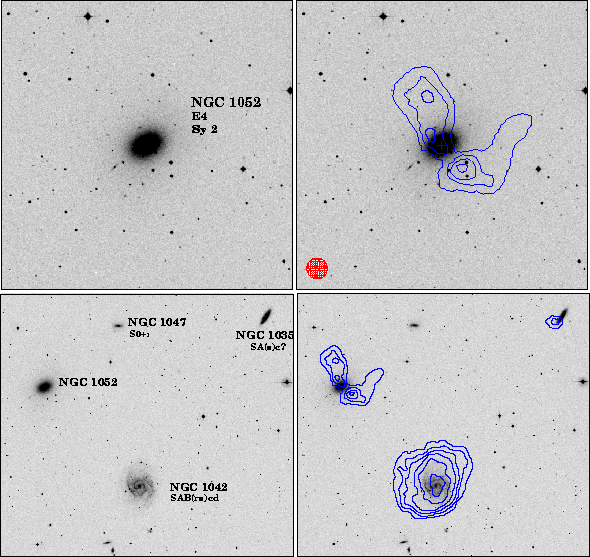
(Figure 136: The NGC 1052 System.
HI: VLA D-array, 60" x 60" resolution, contour
levels = (1.5,
6.0, 10.7,
18.3, 27.5,
36.5) x 1019
cm-2
x 2n.
Optical: DSS, FOV=14' x 14' (top), 31' x 28'
(bottom).
Reference: van Gorkom, J. H., Knapp, G. R.,
Raimond, E., Faber, S. M., Gallagher, J. S. 1986, AJ
91, 791.)
The Arp 135 system

(Figure 137: The NGC 1023 System.
HI: VLA D-array, 54.5" x 46.7" resolution,
contours=5
x 1018
cm-2
x 2n.
Optical: DSS, FOV=26' x 30'.
Reference: Iyer et al., these
proceedings, p. 860.)
The NGC 4111

(Figure 138: The NGC 4111 System.
HI: VLA D-array, 45'' resolution, contours=2
x 1019
cm-2
x 2n.
Optical: DSS, FOV=15' x 16' (top), 38' x 39'
(bottom).
Notes: One of the three brightest lenticulars
in the Ursa Major cluster, all of which show disturbed
HI.
Reference: Verheijen & Zwaan, these
proceedings, p. 866.)
The NGC 7426 system

(Figure 139: The NGC7426 System.
HI: VLA D-array, 53" x 49" resolution,
contours=1
x 1019
cm-2
x 2n.
Optical: DSS, FOV=27' x 24'.
Reference: Schiminovich et al., these
proceedings, p. 863.)
The NGC 5903 system

(Figure 140: The NGC 5903 System.
HI: VLA DnC-array, 46" x 45" resolution,
contoured at (0.4,
1.2, 1.7, 2.3,
2.9, 3.5, 4.1,
4.7, 5.2) x 1020
cm-2
x 2n.
Optical: DSS, FOV=12 x 22'.
Notes: ESO 512-G003 does not have a known
redshift.
Reference: Appleton, P. N., Pedlar, A., &
Wilkinson, A. 1990, ApJ 357, 426.)
The Leo Ring system

(Figure 141: The Leo Ring System.
HI: Arecibo single dish map, 3.3' resolution,
contours=2
x 1018
cm-2
x 2n.
Optical: DSS, FOV=70' x 100'.
Notes: Labeled galaxies have redshifts similar
to the ring.
Reference: Schneider, S.E., Skrutskie, M.F.,
Hacking, P.B., Young, J.S., Dickman, R.L., Claussen,
M.J., Salpeter, E.E., Houck, J.R., Terzian, Y., Lewis,
B.M., & Shure, M. A. 1989, AJ 97,
666.)
The NGC 5291 system

(Figure 142: The NGC 5291 System.
HI: VLA C+D-array, 26" x 15" resolution,
contours=1 x
1020
cm-2
x 2n.
Optical: DSS, FOV=9' x 12'.
Reference: Malphrus, B. K., Simpson, C. E.,
Gottesman, S. T., & Hawarden, T. G. 1997, AJ
114, 1427.)
The NGC 4532 system

(Figure 143: The NGC 4532 System.
HI: Dotted contours: Arecibo single dish
mapping, contours at (2, 4)
x 1019
cm-2
x 2n.
Solid contours: VLA C+D-array, 46" x 42" resolution,
contours=1.8 x
1020
cm-2
x 2n.
Optical: DSS, FOV=18' x 18'.
Reference: Hoffman, G. L., Lu, N. Y., Salpeter,
E. E., & Connell, B. M. 1999, AJ 117,
811.)
The NGC 2964 / 2968 / 2970 system

(Figure 144: The NGC 2964 / 2968 / 2970 System.
HI: VLA D-array, 60" x 51" resolution,
contours=2
x 1019
cm-2
x 2n.
Optical: DSS, FOV=14' x 14'.
Notes: This system was targeted because of the
presence of the Type I supernova 1970l that was
observed to lie between NGC2968 and NGC2970.
Reference: Tyson & van Gorkom, these
proceedings, p. 864.)
The Arp 317 system

(Figure 145: The Leo Triplet.
HI: Arecibo single dish map. Contours=(3, 5,
10, 15, 25, 50, 75, 100, 200, 400, 600) K km s−1
.
Optical: DSS, FOV=87' x 60'.
Reference: Haynes, M. P., Giovanelli, R.,
Roberts, M.S. 1979, ApJ 229, 83.)
The NGC 3628 system

(Figure 146: The Leo Triplet Member NGC 3628.
HI: VLA D-array, 60'' resolution,
contours=(3.2, 4.8, 6.4, 9.6, 16)
x1020
1019- 19
cm-2.
Optical: Top two panels: DSS, FOV=22' x 8'.
Third panel: DSS, FOV=66' x 22'. Bottom panel: Palomar
48'' Schmidt (B) second blue survey with high-contrast
development by James Schombert, FOV=39' x 10'.
Notes: The dotted boxes in the third panel
delineates the regions shown in the other panels.
Reference: Appleton & Hughes, these
proceedings, p. 856.)
The Arp 141 system

(Figure 147: The Ring Galaxy System Arp 141.
HI: VLA B+C+D-array, 22" x 21" resolution,
contours=3
x 1019
cm-2
x 2n.
Optical: DSS, FOV=14' x 11'.
Reference: Higdon et al., these
proceedings, p. 859.)
The 5915 / 6 system

(Figure 148: The NGC 5915/6 System.
HI: VLA D-array, 60'' resolution, contours=4
x 1019
cm-2
x 2n.
Optical: DSS, FOV=13' x 14'.
Reference: Hameed & Young, these
proceedings, p. 857.)
The Arp 314 system

(Figure 149: The Arp 314 System.
HI: VLA D-array, 72'' resolution, contours=1
x 1019
cm-2
x 2n.
Optical: Palomar 5m Gunn r, FOV=11' x
11'.
Reference: Nordgren, T. E., Chengalur, J. N.,
Salpeter, E. E., & Terzian, Y. 1997, AJ 114,
913.)
The Arp 313 system

(Figure 150: The Arp 313 System.
HI: Lower left panel: WSRT, 30'' resolution,
contours=5
x 1019
cm-2
x 2n. Lower
right panel: VLA D-array, 48" x 44" resolution.
Optical: DSS, FOV=14.0' x 11.6'.
Notes: The dotted outline in the lower left
panel delineates the region shown in the other panels.
Reference: WSRT observations: Swaters, R. A.,
1999, PhD thesis, Rijksuniversiteit Groningen, and
Swaters, R.A., van Albada, T.S., van der Hulst, J.M.,
& Sancisi, R., 2001, A&AS, submitted. VLA
observations: Wilcots, E.M., & Prescott, M.K.,
2001, AJ submitted.)
The NGC 5506 / 7 system

(Figure 151: The NGC5506/7 System.
HI: VLA D-array, 60" x 47.4" resolution,
contours=1
x 1019
cm-2
x 2ncm-2 x 2n.
Optical: DSS, FOV=30' x 30'.
Notes: The arrows indicate objects identified
in the APMUKS survey. None of the other concentrations
has a cataloged counterpart. A higher-resolution map
of NGC5506/7 is shown in Fig. 99.
Reference: Mundell, these proceedings,
p. 411.)
The NGC 92 system

(Figure 152: The NGC 92 System.
HI: ATCA, 104" x 51" resolution, contours=1,
3,...,
x 1019
cm-2.
Optical: DSS, FOV=7' x 6'.
Reference: Oosterloo, T., & Iovina, A.,
1997, PASA 14, 48.)
The NGC 6845 system

(Figure 153: The NGC 6845 System.
HI: VLA DnC-array, 112" x 37" resolution,
contours=2
x 1019
cm-2
x 2n.
Optical: CASLEO 2.15m R-band, FOV=7' x
7'.
Reference: Rodrigues, I., Dottori, H., Brinks,
E., & Mirabel, I.F. 1999, AJ 117,
2695.)
The VV 491 / HCG 26 system

(Figure 154: The Compact Group HCG 26.
HI: VLA C-array, 30'' resolution, contours=2
x 1019
cm-2
x 2n.
Optical: DSS, FOV=5.8' x 4.5'.
Reference: Williams, B. A., & van Gorkom,
J. H. 1995, in ASP Conf. Ser., Vol. 70,
Groups of Galaxies, ed. O. G.Richter and
K. Borne (ASP, SF), 77. See also
Verdes-Montenegro, these proceedings, p. 193.)
The Arp 182 system
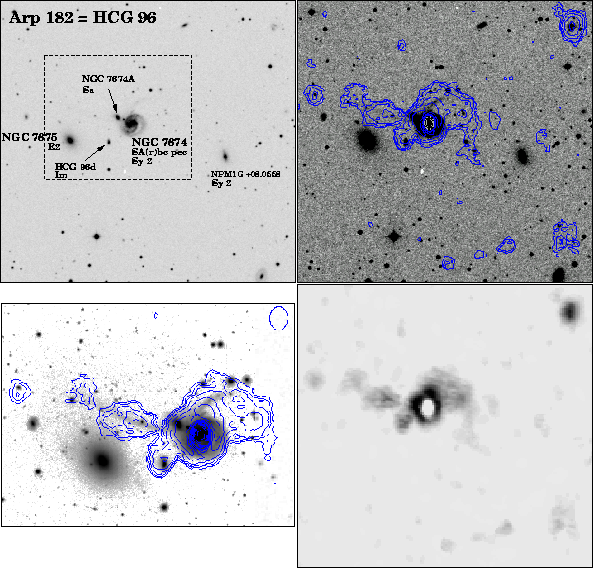
(Figure 155: The Compact Group HCG 96.
HI: VLA C+D-array, 33" x 25" resolution. Right
hand panels: contours=3
x 1019
cm-2
x 2n.
Bottom left panel: contours=(0.5, 1, 1.5, 2, 3.5, 5)
x 1020 cm-2.
Optical: Bottom left: Nordic Optical Telescope
R-band. Others: DSS, FOV=11' x 11'.
Notes: The dotted box in the top left panel
shows the region displayed in the bottom left panel.
Reference: Verdes-Montenegro et al.,
these proceedings, p. 865. See also
Verdes-Montenegro, these proceedings, p. 193 and
Mundell, these proceedings, p. 411.)
The Arp 150 system

(Figure 156: The Compact Group HCG 95.
HI: VLA C+D-array, 23" x 16" resolution,
contours=1
x 1020
cm-2
x 2n.
Optical: 3.5m Calar Alto B-band,
FOV=4.6' x 3.3'.
Reference: Verdes-Montenegro, L., Yun, M. S.,
Williams, B. A., Huchtmeier, W. K., Del Olmo, A.,
& Perea, J. 2000, IAU Colloq. 174, Small
Galaxy Groups, ed. M. Valtonen & C. Flynn
(San Francisco: ASP), 167. See also Verdes-Montenegro,
these proceedings, p. 193.)
The Stephan's Quintet system

(Figure 157: Stephan's Quintet.
HI: VLA B+D-array, 19.7" x 18.8" resolution,
contours=5
x 1019
cm-2
x 2n.
Optical: DSS, FOV=7.6' x 6'.
Notes: There are three other small detected
members of the group found outside of the region
shown.
Reference: Williams et al., these
proceedings, p. 867.)
Even though the Stephan's Quintet system has
discordant redshifts associated therewith, the neutral hydrogen
profile suggests interactions. For more, see chapter
The Arp 31 / NGC 691 system

(Figure 158: The NGC 691 Group.
HI: VLA D-array, 56'', contours=(1.4, 4.1, 12.3,
27.3, 61.6)
x 1019
cm-2.
Optical: DSS, FOV=30' x 24'.
Notes: Includes the interacting systems
N678/680 (Fig. 121)
and Arp 31 (Fig. 34).
Reference: van Moorsel, G. A., 1988, A&A
202, 59.)
The Arp 295 system

(Figure 159: The Arp 295 System.
HI: VLA C+D-array, 26'' resolution, contours=4
x 1019
cm-2
x 2n.
Optical: KPNO 0.9m V-band, FOV=15' x
15'.
Notes: The detected companion [Hv96] G9
lies 21' to the southeast.
Reference: Hibbard, J. E., & van Gorkom, J.
H. 1996, AJ 111, 655.)
The NGC 4410 system

(Figure 160: The NGC 4410 Group.
HI: VLA D-array, 58.4" x 54.7" resolution,
contours=2
x 1019
cm-2
x 2n.
Optical: DSS, FOV=8' x 7' (top), 26' x 23'
(bottom).
Reference: Smith, B.J., 2000, , 541, 624. See
also Smith, Donahue & Stocke, these proceedings,
p. 592.)
The NGC 3656 system

(Figure 161: The NGC 3656 Group.
HI: VLA C+D-array, 25.2" x 19.7" resolution,
contours=2
x 1019
cm-2
x 2n.
Optical: DSS, FOV=24' x 14'.
Notes: For close-up of NGC3656, see Fig. 125.
Reference: Balcells, M., van Gorkom, J.H.,
Sancisi, R., & del Burgo, C. 2001, AJ in
press.)
The HCG 23 system
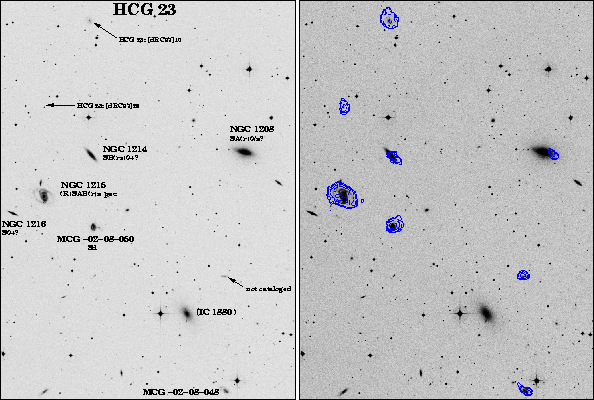
(Figure 162: The Compact Group HCG 23.
HI: VLA C-array, 21.5" x 17.1" resolution,
contours=1
x 1020
cm-2
x 2n.
Optical: DSS, FOV=21' x 28'.
Reference: Williams, B. A., & van Gorkom,
J. H. 1995, in ASP Conf. Ser., Vol. 70,
Groups of Galaxies, ed. O. G.Richter and
K. Borne (ASP, SF), 77. See also
Verdes-Montenegro, these proceedings, p. 193.)
The NGC 5198 'system'

(Figure 163: The NGC 5198 System.
HI: VLA D-array, 48.2" x 42.5" resolution,
contours=2
x 1019
cm-2
x 2n.
Optical: DSS, FOV=29' x 30'.
Reference: Schiminovich et al., these
proceedings, p. 863.)
The Ursa Major cluster

(Figure 164: in the Ursa Major Cluster.
HI: WSRT, 30'' resolution.
Notes: The following galaxies appear separately
within the Gallery: NGC3718/29 (Fig. 13);
NGC3769 (Fig. 42);
NGC3893/96 (Fig. 50);
NGC3992 & UGC6923/40/69 (Fig. 181);
NGC4013 (Fig. 15);
NGC4085/88 (Fig. 55);
UGC6962/73 (Fig. 80).
Reference: Verheijen, M. A. W., & Sancisi,
R. 2001, A&A 370, 765. See also
Verheijen, these proceedings, p. 573.)
The HCG 90 system
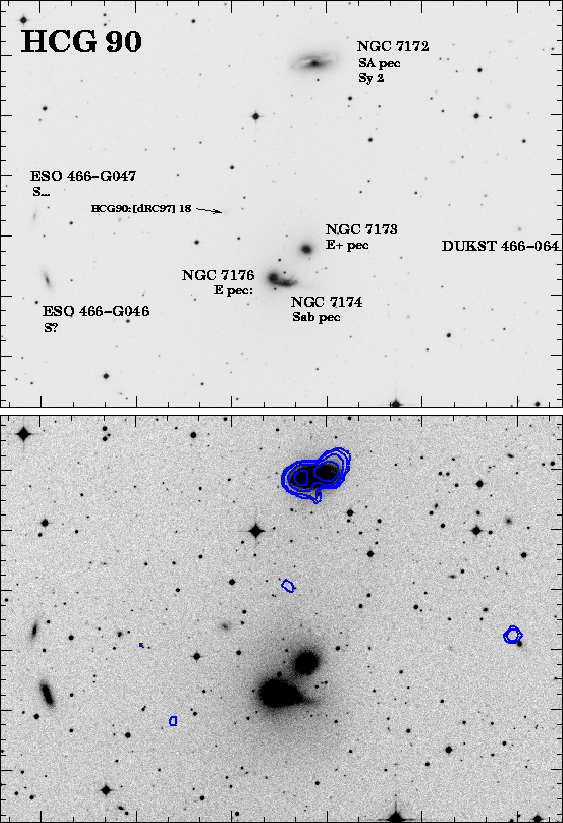
(Figure 165: The Compact Group HCG 90.
HI: VLA D-array, 44" x 38" resolution,
contours=4
x 1020
cm-2
x 2n.
Optical: DSS, FOV=20' x 14'.
Notes: All galaxies with known redshifts
falling within the passband of the observations have
been labeled.
Reference: Rupen, Hibbard & Bunker, these
proceedings, p. 863.)
The Pegasus I system

(Figure 166: The Pegasus I Group.
HI: VLA D-array, 54" x 50" resolution,
contours=1
x 1019
cm-2
x 2n.
Optical: DSS, FOV=40' x 40'.
Notes: The contours represent the combination
of two separate observations: a pointing centered on
NGC7626 (3423 km s−1
) which found in the galaxy UGC12510 and in cloud
lying between NGC7626 and NGC7619; and a separate
pointing centered on NGC7617 (4010 km s−1
) which found everything else.
Reference: Observations centered on NGC7626:
Hibbard & Sansom, these proceedings, p. 858.
Observations centered on NGC7617: Schiminovich et
al., these proceedings, p. 863.)
The Virgo Cluster near M86

(Figure 167: The Virgo Cluster near M86.
HI: VLA D-array, 58" x 48" resolution,
contours=2
x 1019
cm-2
x 2n.
Optical: DSS, FOV=47' x 43'.
Notes: Galaxies labeled in parenthesis have
velocities that fall outside of the observed range.
Reference: Li & van Gorkom, these
proceedings, p. 637.)
Some low redshift quasars

(Figure 168: in low-redshift QSOs.
HI: VLA C-array. FWHM resolution indicated by
circle drawn in lower left panel of each plot.
Optical: DSS, except for I Zw 1 taken from the
Hubble Space Telescope archive.
Notes: The QSO and its host galaxy (where
visible) is shown magnified in the lower right inset
of each panel.
Reference: Lim, J., & Ho, P.T.P. 1999, ApJ
510, L7, and Lim et al., these
proceedings, p. 111.)
The EA1 system
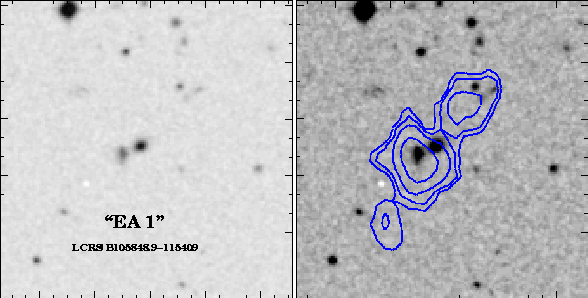
(Figure 169: The E+A Galaxy EA1.
HI: VLA C-array, 26.0" x19.3" resolution,
contours=3
x 1019
cm-2
x 2n.
Optical: DSS, FOV=2.6' x 2.6'.
Notes: Selected for having a post-starburst or
``E+A'' (a.k.a. ``K+A'') spectrum.
Reference: Chang, T-C., van Gorkom, J. H.,
Zabludoff, A. I., Zaritsky, D., & Mihos, J. C.
2001, AJ 121, 1965 and Chang et al.,
these proceedings, p. 634.)
The Arp 6 system

(Figure 170: The Arp 6 System.
HI: WSRT, 30'' resolution, contours=3
x 1019
cm-2
x 2n.
Optical: DSS, FOV=6' x 5'.
Reference: Swaters, R. A., 1999, PhD thesis,
Rijksuniversiteit Groningen, and Swaters, & R.A.,
van Albada, T.S., van der Hulst, J.M., Sancisi, R.,
2001, A&AS, submitted.)
The Arp 264 system

(Figure 171: The Arp 264 System.
HI: WSRT, 30'' resolution, contours=1
x 1020
cm-2
x 2n.
Optical: DSS, FOV=8' x 8'.
Reference: Swaters, R. A., 1999, PhD thesis,
Rijksuniversiteit Groningen, and Swaters, & R.A.,
van Albada, T.S., van der Hulst, J.M., Sancisi, R.,
2001, A&AS submitted.)
The UGC 8201 / VII Zw 499 system

(Figure 172: The UGC 8201 System.
HI: WSRT, 30'' resolution, contours=1.5
x 1020
cm-2
x 2n.
Optical: DSS, FOV=8' x 8'.
Reference: Swaters, R. A., 1999, PhD thesis,
Rijksuniversiteit Groningen, and Swaters, R.A., van
Albada, T.S., van der Hulst, J.M., & Sancisi, R.,
2001, A&AS submitted.)
The Mrk 71 / NGC 2363 / 6 system

(Figure 173: The Blue Compact Dwarf system
NGC2363/6.
HI: VLA C-array, 17" x 15" resolution,
contours=1
x 1020
cm-2
x 2n.
Optical: DSS, FOV=12' x 13'.
Reference: Thuan, Hibbard & Levrier, these
proceedings, p. 864. See also Hunter, D.A.,
Elmegreen, B.G., & van Woerden, H. 2001, ApJ
556, 773.)
The Arp 268 / Holmberg II system

(Figure 174: The Holmberg II System.
HI: WSRT, 30'' resolution, contours=1
x 1020
cm-2
x 2n.
Optical: DSS, FOV=20.6' x 20.6'.
Reference: Swaters, R. A., 1999, PhD thesis,
Rijksuniversiteit Groningen, and Swaters, & R.A.,
van Albada, T.S., van der Hulst, J.M., Sancisi, R.,
2001, A&AS submitted.)
The Arp 2 system
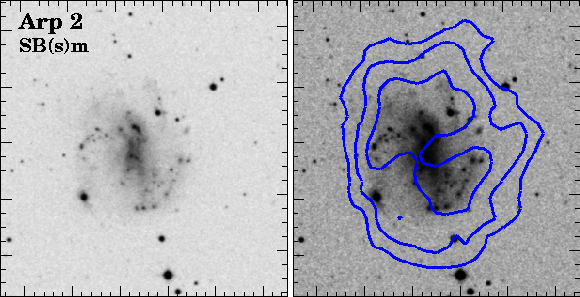
(Figure 175: The Arp 2 System.
HI: WSRT, 30'' resolution, contours=2
x 1020
cm-2
x 2n.
Optical: DSS, FOV=5.0' x 5.2'.
Reference: Swaters, R. A., 1999, PhD thesis,
Rijksuniversiteit Groningen, and Swaters, & R.A.,
van Albada, T.S., van der Hulst, J.M., Sancisi, R.,
2001, A&AS submitted.)
The NGC 662 system

(Figure 176: The NGC 0662 System.
HI: VLA D-array, 52.4" x 48.4" resolution,
contours=1
x 1019
cm-2
x 2n.
Optical: DSS, FOV=5' x 4'.
Reference: Schiminovich et al., these
proceedings, p. 863.)
The UGC 1503 system

(Figure 177: The low-luminosity elliptical UGC
1503.
HI: VLA D-array, 55" x 49" resolution,
contours=1
x 1019
cm-2
x 2n.
Optical: DSS, FOV=4' x 4'.
Notes: The distribution in this system is
fairly typical of low luminosity ellipticals as a
class; see Oosterloo et al., these
proceedings, p. 251.
Reference: Schiminovich et al.,
these proceedings, p. 863.)
The NGC 2328 system

(Figure 178: The IR Bright Early Type NGC 2328.
HI: VLA D-array, 96" x 33" resolution,
contours=5
x 1019
cm-2
x 2n.
Optical: DSS, FOV=6' x 5'.
Reference: Rupen, Hibbard & Bunker, these
proceedings, p. 863.)
The NGC 3273 system

(Figure 179: The IR Bright Early Type NGC 3273.
HI: VLA D-array, 53" x 38" resolution,
contours=5
x 1019
cm-2
x 2n.
Optical: DSS, FOV=5' x 5'.
Reference: Rupen, Hibbard & Bunker, these
proceedings, p. 863.)
The NGC 3044 system

(Figure 180: The Edge-on system NGC 3044.
HI: VLA C-array, 14'' resolution, contours=1
x 1020
cm-2
x 2n.
Optical: DSS, FOV=5.8' x 3.9'.
Reference: Lee, S.-W. & Irwin, J.A. 1997, ApJ
490, 247.)
The M109 system

(Figure
181: The M109 System.
HI: WSRT, 60'' resolution, contours=1
x 1020
cm-2
x 2n.
Optical: DSS, FOV=22' x 22'.
Notes: Member of the Ursa Major Cluster. See also
Fig. 164.
Reference: Verheijen, M. A. W., & Sancisi, R.
2001, A&A 370, 765.)
Prediction: Many of these wonderful HI radio galaxy systems when re-examined in wider panoramic views will have both (a) along the minor, rotational axis and along (b) the lateral axis of rotation, &c., many more associated compact and other AGNs, QSOs, BSOs, BL Lac objects, and disturbed or companion galaxies with elevated and descending anomalous redshifts (only anomalous to the New Ptolemaic HBBC paradigm) distributed non-randomly, centered on these active galaxies. Many of these data are already extant as we will see. This is keeping with the observational predictions of the Ambartsumian Vorontsov-Vel'yaminov Arp (AVVA) cosmogony.
 |
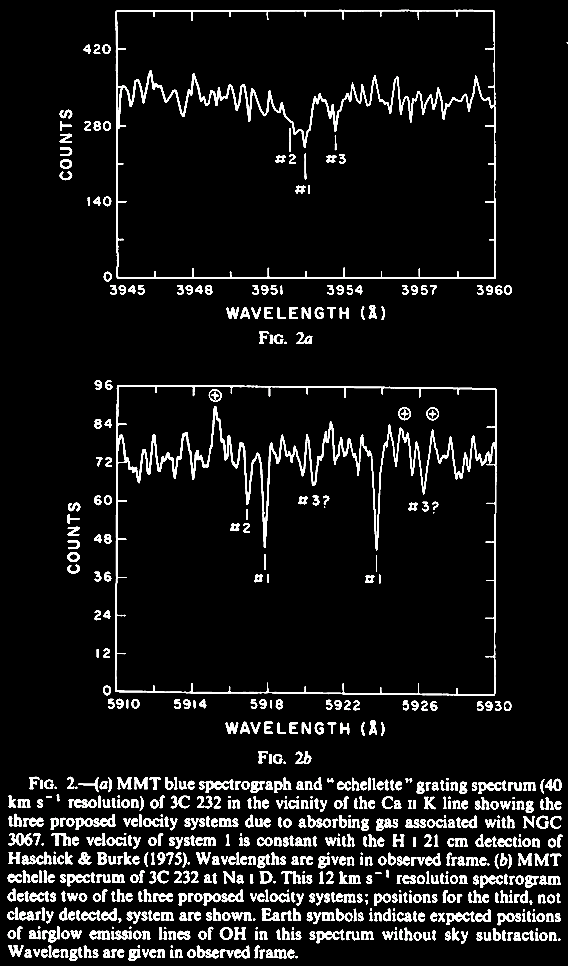 |
 |
 |
 |
 |



 |
 |
 |
Although the data are fainter than
expected, there is indeed an HI neutral hydrogen
emission and a weak absorption line at the expected
hydrogen absorption against quasar 3C 275.1 (which
itself has ejected a "blob" with an apparent
superluminal velocity of v ~ 10c),
and has a redshift ~150 times larger than the galaxy
NGC 4651. It is interesting that there is a continuum of changing redshift velocities of the integrated H I emission in NBC 4651 across the system(s). See Fig. 3. An emission peak occurs ~634 km s−1 while there is an absorption feature at ~643 km s−1 , for which the authors did not have an adequate explanation. |
 Notice the peculiarity of the line of compact radio sources, interpreted as giant, dense molecular clouds where there are high rates of star formation. |
 |
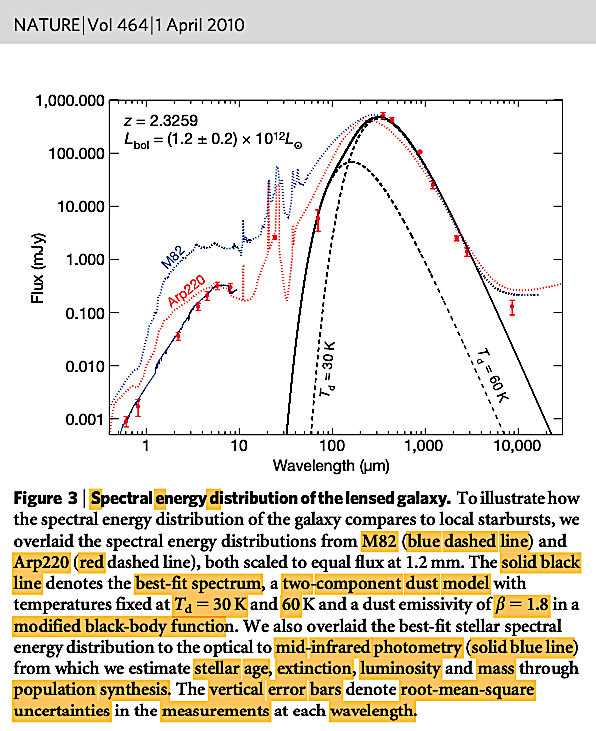 |
 |



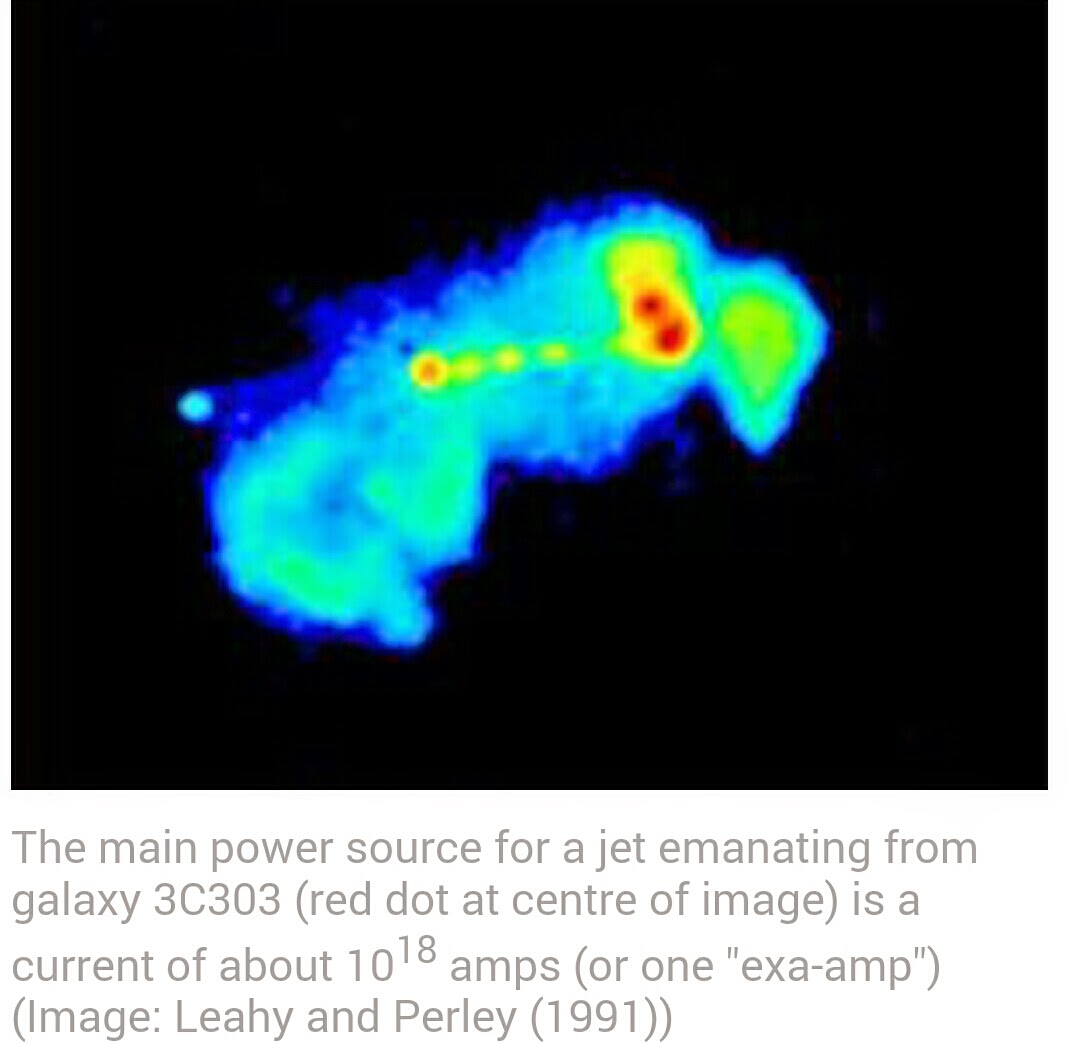
The Cygnus A system



 |
 |
 |
 |





One recent finding in
extragalactic radio astronomy suggests that giant radio
galaxies (GRGs) are more common than our radio resolution has
realized heretofore. A post-doc at Capetown University,
Jacinta Delhaize and colleagues discovered two GRGs (link):
Delhaize et al. 2021. MIGHTEE: Are giant radio
galaxies more common than we thought? MNRAS 501
(3), 3833. https://doi.org/10.1093/mnras/staa3837,
using the South African Radio Astronomy Observatory (SARAO)
MeerKAT, an interlinked complex of 64 radio telescope
antennae, a precursor to the Square Kilometer Array (SKA). The
higher resolution and greater sensitivity of MeerKAT made this
possible.
The increased imaging
resolution and surface luminosity sensitivity of MeerKAT
allows us to examine the morphology of GRGs. By definition,
the projected linear size of GRGs with their jets and lobes
are >0.7 Mpc, and they are considered the largest
individual objects in the Universe. Both GRG1 and GRG2,
respectively 2.4 Mpc and 2.0 Mpc in size, were found within a
~1 deg2 region in the COSMOS field in the MeerKAT
International GHz Tiered Extragalactic Exploration (MIGHTEE)
survey. Their respective redshifts were GRG1 z =
0.1656 (a look-back time of 2.076 Gya), and GRG2 z = 0.3363 (a look-back
time of 3.779 Gya). The
estimated Poisson distribution likelihood of finding these z < 0.4 in such a small
angular region is only about 2.7 x 10-6. This
suggests that a lot more will be found in the MIGHTEE survey,
and even more using the future SKA.
 |
 |
 |
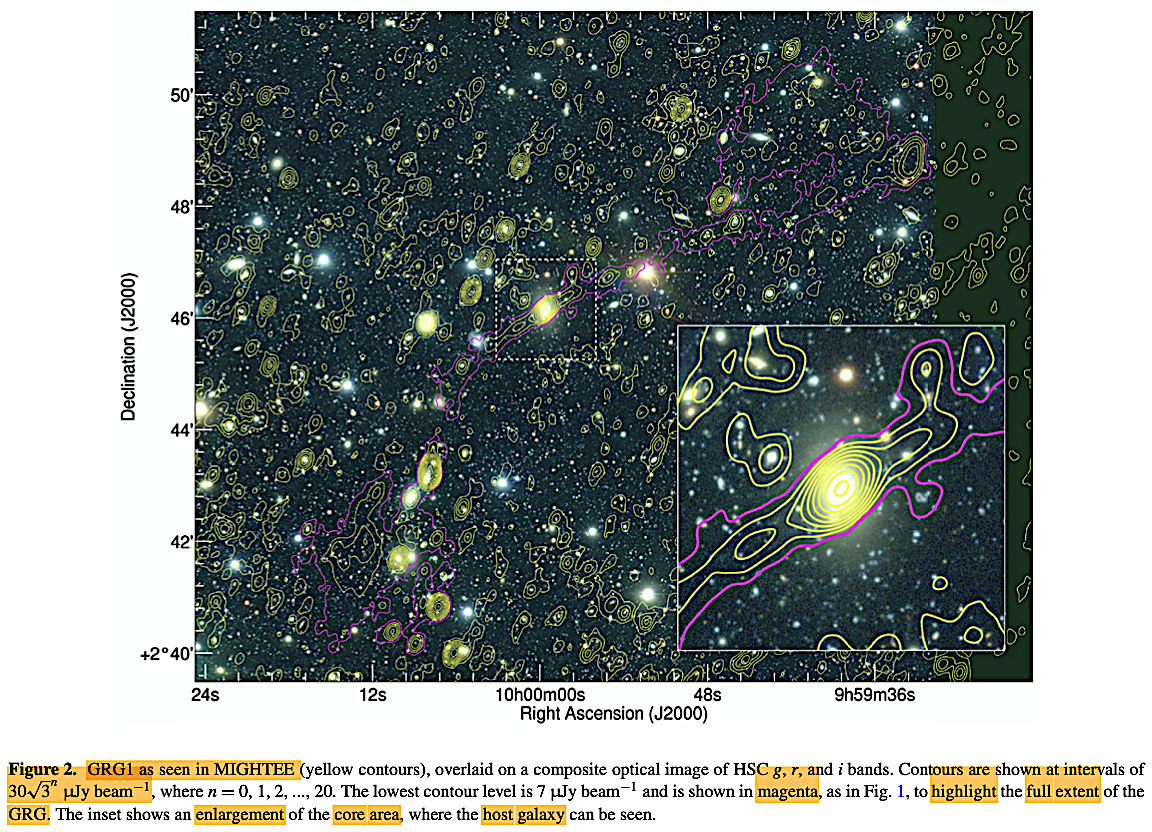 |
 Inverted image with green instead of magenta to better visualize the extent of GRG1. |
 |
 Inverted image: Dashed line red = cyan; black line = white. |
 |
 Inverted image with green instead of magenta to better visualize the extent of GRG2. |
 |
Many more giant radio
galaxies (GRGs) will doubtless be discovered in the future,
and add their exciting data to the quest for a more accurate
cosmology.
Summary: It is evident that extremely high-energy explosive-ejective events are occurring in the powerful centers and environs of the so-called 'radio galaxies,' and curiously sometimes, compact sources seem to be aligned as if emerging from the central AGN of the radio galaxies in question. Whether the current models of massive black hole accretion disc phenomena are an adequate energy source or cosmogonic dynamics probably awaits further confirmation, to say the very least, and quite likely, there are new, yet to be discovered processes occurring. Could these explosive events be related to the ejection-jet and galactic alignment event-phenomena documented from the peer-reviewed scientific literature in the following pages?